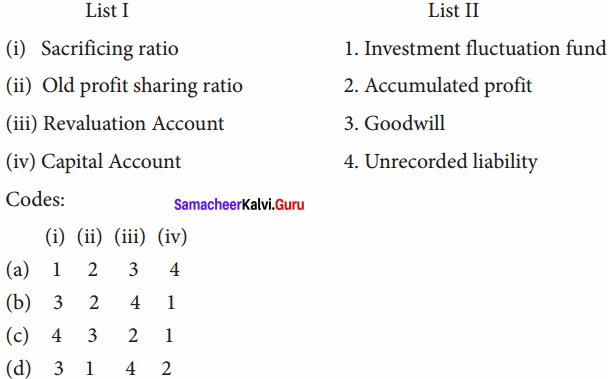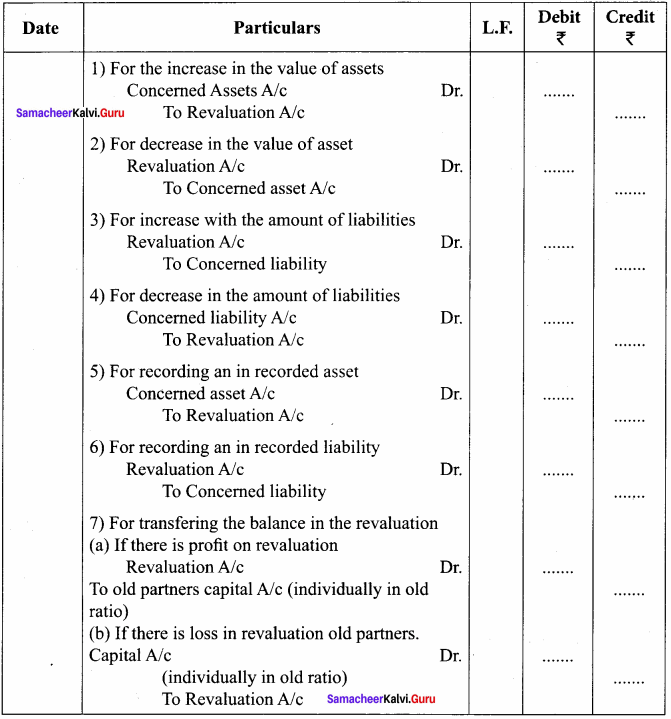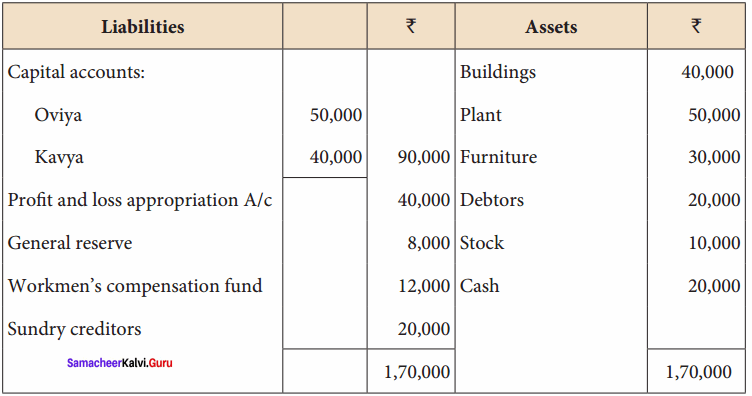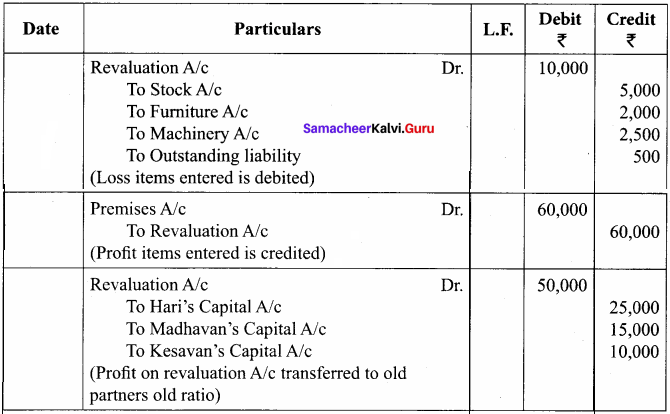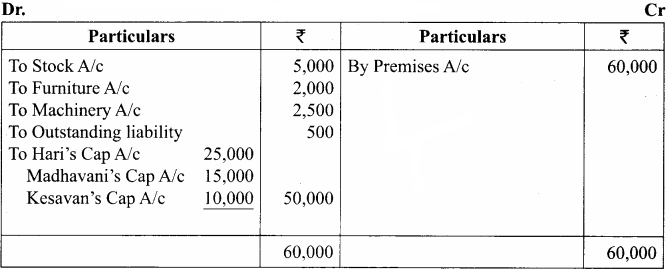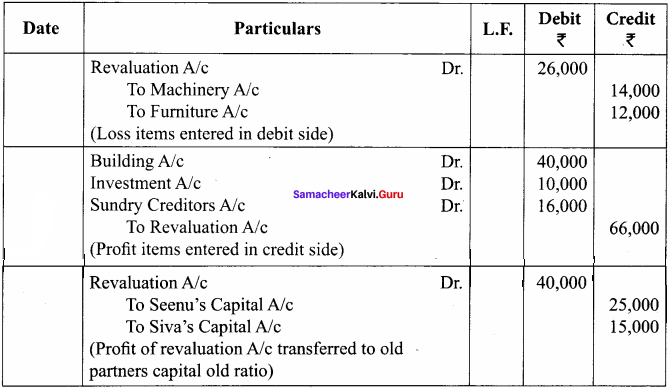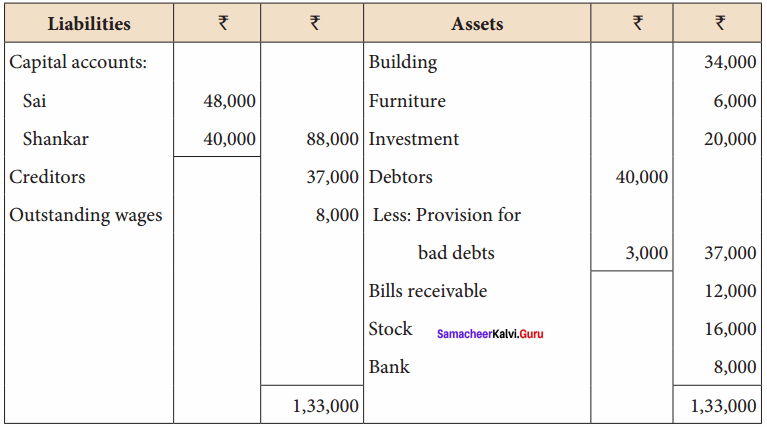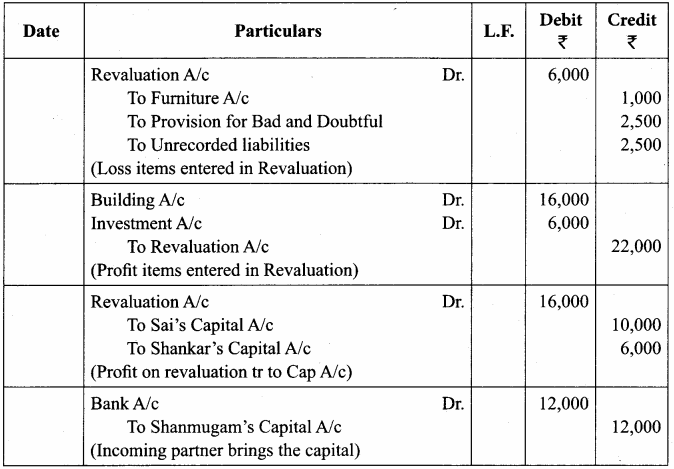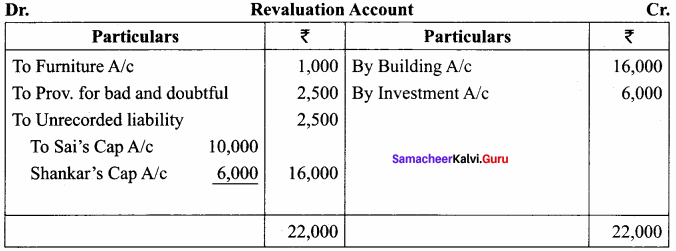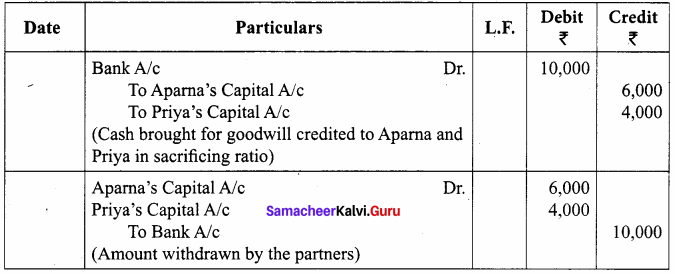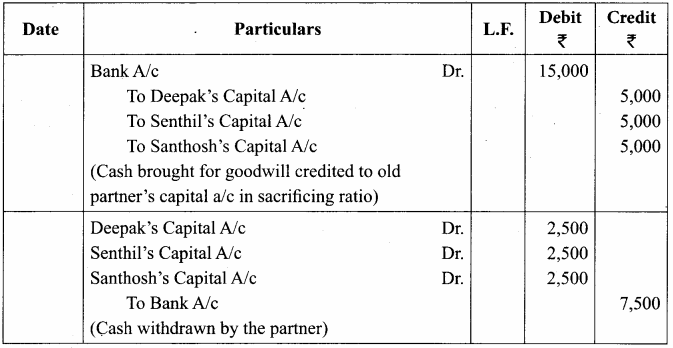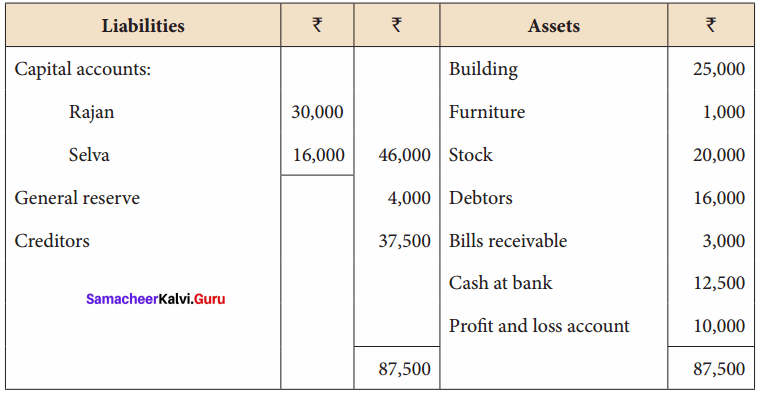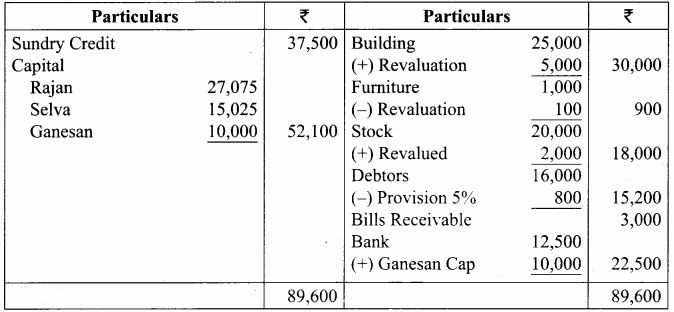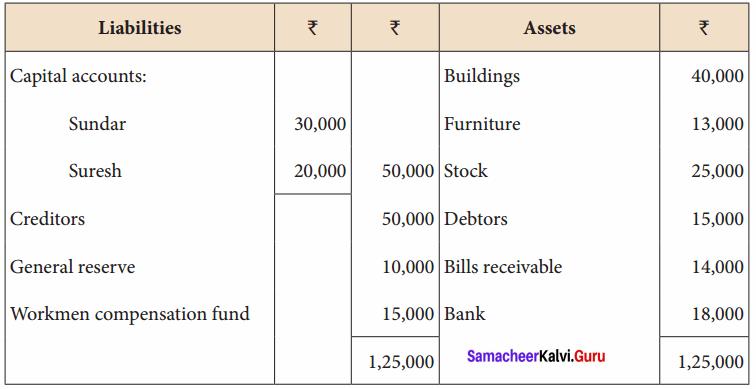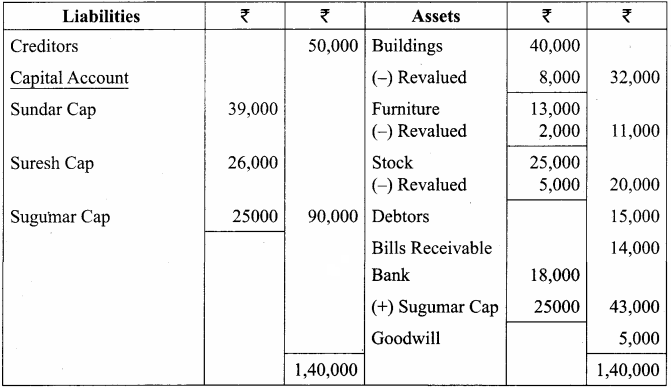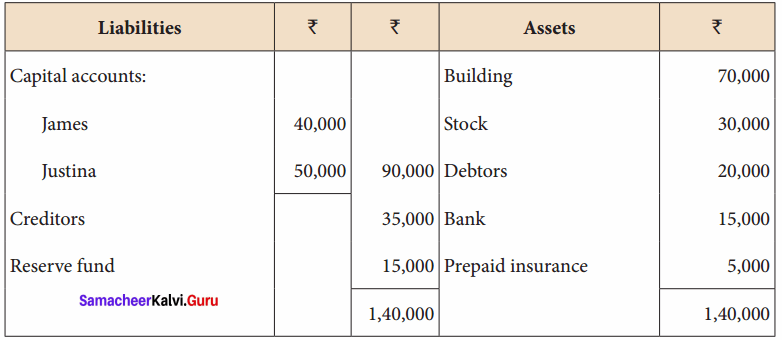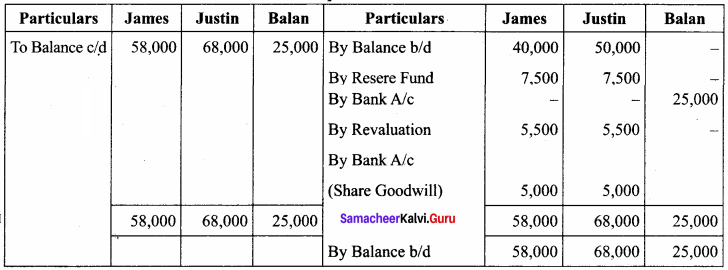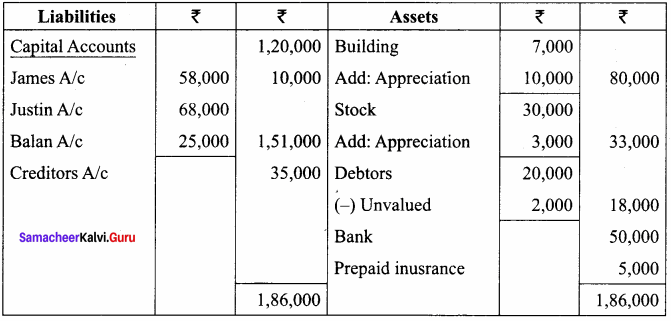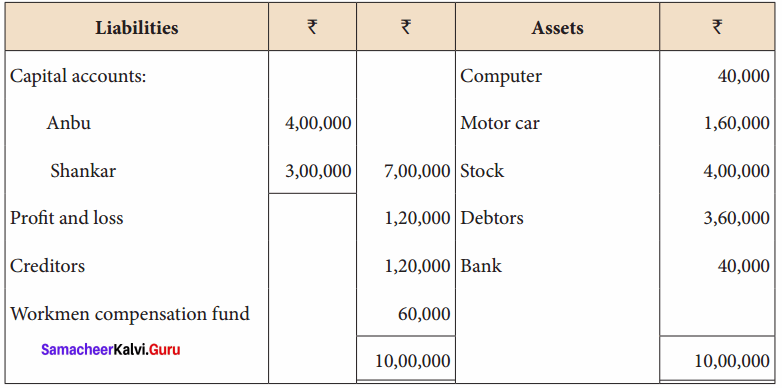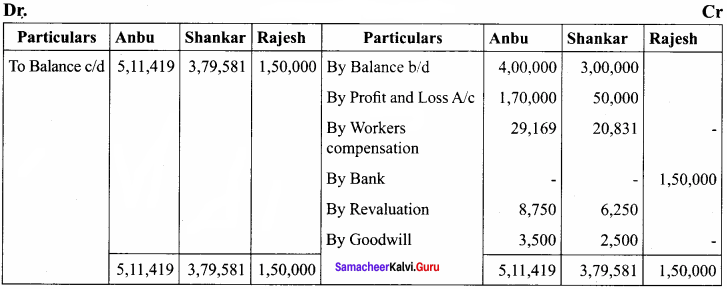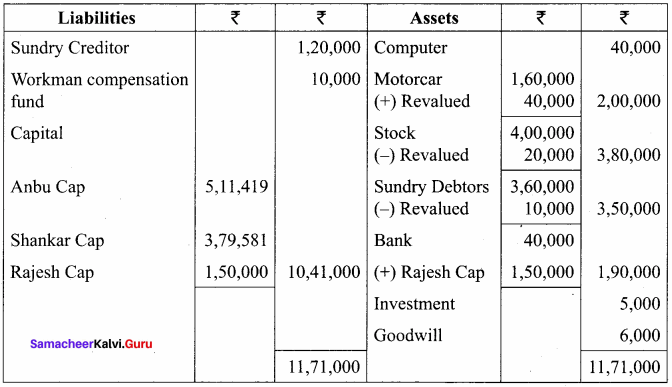Students can Download Bio Botany Chapter 1 Asexual and Sexual Reproduction in Plants Questions and Answers, Notes Pdf, Samacheer Kalvi 12th Bio Botany Book Solutions Guide Pdf helps you to revise the complete Tamilnadu State Board New Syllabus and score more marks in your examinations.
Tamilnadu Samacheer Kalvi 12th Bio Botany Solutions Chapter 1 Asexual and Sexual Reproduction in Plants
Samacheer Kalvi 12th Bio Botany Asexual and Sexual Reproduction in Plants Text Book Back Questions and Answers
Question 1.
Choose the correct statement from the following
(a) Gametes are involved in asexual reproduction
(b) Bacteria reproduce asexually by budding
(c) Conidia formation is a method of sexual reproduction
(d) Yeast reproduce by budding
Answer:
(c) Conidia formation is a method of sexual reproduction
Question 2.
An eminent Indian embryologist is ____________
(a) S.R. Kashyap
(b) P. Maheswari
(c) M.S. Swaminathan
(d) K.C. Mehta
Answer:
(b) P. Maheswari
Question 3.
Identity the correctly matched pair ____________
(a) Tuber – Allium cepa
(b) Sucker – Pistia
(c) Rhizome – Musa
(d) Stolon – Zingiber
Answer:
(c) Rhizome – Musa

Question 4.
Pollen tube was discovered by ____________
(a) J.G. Kolreuter
(b) G.B. Amici
(c) E. Strasburger
(d) E. Hanning
Answer:
(b) G.B. Amici
Question 5.
Size of pollen grain in Myosotis ____________
(a) 10 micrometer
(b) 20 micrometer
(c) 200 micrometer
(d) 2000 micrometer
Answer:
(a) 10 micrometer
Question 6.
First cell of male gametophyte in angiosperm is ____________
(a) Microspore
(b) Megaspore
(c) Nucleus
(d) Primary Endosperm Nucleus
Answer:
(a) Microspore
Question 7.
Match the following ____________
(I) External fertilization – (i) pollen grain
(II) Androecium – (ii) anther wall
(III) Male gametophyte – (iii) algae
(IV) Primary parietal layer – (iv) stamens
(a) I-(iv); II-(i); III-(ii); IV-(iii)
(b) I-(iii); II-(iv); III-(ii); IV-(i)
(c) l-(iii); II-(iv); III-(ii); IV-(i)
(d) I-(iii); II-(i); III-(iv); IV-(ii)
Answer:
(b) I-(iii); II-(iv); III-(ii); IV-(i)
Question 8.
Arrange the layers of anther wall from locus to periphery
(a) Epidermis,middle layers, tapetum, endothecium
(b) Tapetum, middle layers, epidermis, endothecium
(c) Endothecium, epidermis, middle layers, tapetum
(d) Tapetum, middle layers endothecium epidermis
Answer:
(d) Tapetum, middle layers endothecium epidermis
Question 9.
Identify the incorrect pair
(a) sporopollenin – exine of pollen grain
(b) tapetum – nutritive tissue for developing microspores
(c) Nucellus – nutritive tissue for developing embryo
(d) obturator – directs the pollen tube into micropyle
Answer:
(c) Nucellus – nutritive tissue for developing embryo
Question 10.
Assertion : Sporopollenin preserves pollen in fossil deposits
Reason : Sporopollenin is resistant to physical and biological decomposition
(a) assertion is true; reason is false
(b) assertion is false; reason is true
(c) Both Assertion and reason are not true
(d) Both Assertion and reason are true.
Answer:
(b) assertion is false; reason is true
Question 11.
Choose the correct statement(s) about tenuinucellate ovule
(a) Sporogenous cell is hypodermal
(b) Ovules have fairly large nucellus
(c) sporogenous cell is epidermal
(d) ovules have single layer of nucellus tissue
Answer:
(a) Sporogenous cell is hypodermal
Question 12.
Which of the following represent megagametophyte ____________
(a) Ovule
(b) Embryo sac
(c) Nucellus
(d) Endosperm
Answer:
(b) Embryo sac
Question 13.
In Haplopappus gracilis, number of chromosomes in cells of nucellus is 4. What will be the chromosome number in Primary endosperm cell?
(a) 8
(b) 12
(c) 6
(d) 2
Answer:
(b) 12

Question 14.
Transmitting tissue is found in
(a) Micropylar region of ovule
(b) Pollen tube wall
(c) Stylar region of gynoecium
(d) Integument
Answer:
(c) Stylar region of gynoecium
Question 15.
The scar left by funiculus in the seed is ____________
(a) tegmen
(b) radicle
(c) epicotyl
(d) hilum
Answer:
(d) hilum
Question 16.
A Plant called X possesses small flower with reduced perianth and versatile anther. The probable agent for pollination would be ____________
(a) water
(b) air
(c) butterflies
(d) beetles
Answer:
(b) air
Question 17.
Consider the following statement(s)
- In Protandrous flowers pistil matures earlier
- In Protogynous flowers pistil matures earlier
- Herkogamy is noticed in unisexual flowers
- Distyly is present in Primula
(a) i and ii are correct
(b) ii and iv are correct
(c) ii and Hi are correct
(d) i and iv are correct
Answer:
(b) ii and iv are correct
Question 18.
Coelorhiza is found in ____________
(a) Paddy
(b) Bean
(c) Pea
(d) Tridax
Answer:
(a) Paddy
Question 19.
Parthenocarpic fruits lack ____________
(a) Endocarp
(b) Epicarp
(c) Mesocarp
(d) seed
Answer:
(d) seed
Question 20.
In majority of plants pollen is liberated at ____________
(a) 1 celled stage
(b) 2 celled stage
(c) 3 celled stage
(d) 4 celled stage
Answer:
(b) 2 celled stage
Question 21.
What is reproduction?
Answer:
- It is a vital process for the existence of a species.
- It brings suitable changes through variation in offsprings.
- Plant reproduction is important for the existence of all other organisms.
Question 22.
Mention the contribution of Hofmeister towards Embryology.
Answer:
Hofmeister described the structure of pollen tetrad
Question 23.
List out two sub-aerial stem modifications with example.
Answer:
Subaerial stem modifications.
The stem is partly aerial and partly underground.
a) Runner. (Ex. oxalis, Centella Asiatica)
- It is running horizontally on the soil surface.
- Nodes have axillary buds, scale leaves, and adventitious roots.
- Runner arises from the axillary bud.
- Mother plant produces many runners in all directions.
- They break off and grow into individual plants.
b) Sucker. (Ex. Musa (banana), chrysanthemum)
Grows horizontally for a distance under the soil. Then it emerges obliquely upwards.
c) Stolon (Ex. Strawberry, Vallisneria)
Develop from underground stems.
They grow horizontally outwards.
d) Offset (condensed runners)
Unlike runners, they produce tilt of leaves above and duster of roots below Ex. Pistia, Eichhornia.
Question 24.
What is layering?
Answer:
Layering is a conventional propagation method, where the stem of a parent plant is allowed to develop roots while still intact. When the root develops, the rooted part is cut and planted to grow as a raw individual. E.g.: Jasminum.
Question 25.
What are clones?
Answer:
The individuals (Ex. Bacteria) formed by this method are morphologically and genetically identical. They are called clones.
Question 26.
A detached leaf of Bryophyllum produces new plants. How?
Answer:
In Bryophyllum, the leaf is succulent and notched on its margin. Adventious buds develop at these notches and are called epiphyllous buds. They develop into new plants forming a root system and become independent plants when the leaf gets decayed.

Question 27.
Differentiate Grafting and Layering.
Answer:
Grafting
- Two different plants are involved.
- Two different plants are joined.
- They continue to grow as one plant.
- The plant in the soil is called stock.
- The plant used for grafting is called the scion.
- Ex. Citrus, Mango, Apple
Layering:
- Only parent plant is involved.
- Stem of the parent plant is allowed to develop roots.
- The rooted part is cut and grown as a new plant.
- Ex. Ixora, Jasminum
Question 28.
Tissue culture is the best method for propagating rare and endangered plant species”- Discuss.
Answer:
Micropropagation of plants in-vitro through tissue culturing is a modem and alternative tool to conserve and safeguard rare plant species. Since the basic principle behind PTC is totipotency. With the help of a single explant, it is possible to generate a huge population of plantlets within a short span of time. Conservation through micropropagation offers the possibility to rescue endangered and endemic species.
Question 29.
Distinguish mound layering and air layering
Answer:
Mound layering
- Flexible branch is buried in the soil.
- Roots emerge from the buried stem.
- Buried part after cutting from for parent, grows into a new plant.
Air layering
- Nodal region is girdled.
- Hormones are applied.
- Rooting is promoted.
- This area is covered by moist soil.
- Roots emerge in 2-4 months.
- These branches removed from parent and grown separately.
Air Layering:
In air layering, the stem is girdled at the nodal part and hormones are applied and covered with moist soil using a polythene sheet. Roots emerge in these branches after 2-4 months. Such branches are removed from parent plant and grown separately.
Question 30.
Explain the conventional methods adopted in vegetative propagation of higher plants.
Answer:
The common methods of conventional propagation are cutting, grafting and layering.
a. Cutting: It is the method of producing a new plant by cutting the plant parts such as root, stem and leaf from the parent plant. The cut part is placed in a suitable medium for growth. It produces root and grows into a new plant. Depending upon the part used it is called as root cutting (Malus), stem cutting (Hibiscus, Bougainvillea and Moringa) and leaf cutting (Begonia, Bryophyllum). Stem cutting is widely used for propagation.
b. Grafting: In this, parts of two different plants are joined so that they continue to grow as one plant. Of the two plants, the plant which is in contact with the soil is called stock and the plant used for grafting is called scion. Examples are Citrus, Mango and Apple. There are different types of grafting based on the method of uniting the scion and stock. They are bud grafting, approach grafting, tongue grafting, crown grafting and wedge grafting.
(i) Bud grafting: AT- shaped incision is made in the stock and the bark is lifted. The scion bud with little wood is placed in the incision beneath the bark and properly bandaged with a tape.
(ii) Approach grafting: In this method both the scion and stock remain rooted. The stock is grown in a pot and it is brought close to the scion. Both of them should have the same thickness. A small slice is cut from both and the cut surfaces are brought near and tied together and held by a tape. After 1-4 weeks the tip of the stock and base of the scion are cut off and detached and grown in a separate pot.
(iii) Tongue grafting: A scion and stock having the same thickness is cut obliquely and the scion is fit into the stock and bound with tape.
(iv) Crown grafting: When the stock is large in size scions are cut into wedge shape and are
inserted on the slits or clefts of the stock and fixed in position using graft wax.
(v) Wedge grafting: In this method, a slit is made in the stock or the bark is cut. A twig of the scion is inserted and tightly bound so that the cambium of the two is joined.
c. Layering: In this method, the stem of a parent plant is allowed to develop roots while still intact. When the root develops, the rooted part is cut and planted to grow as a new plant.
Examples: Ixora mdJasminum Mound layering and Air layering are few types of layering.
(i) Mound layering: This method is applied for the plants having flexible branches. The lower branch with leaves is bent to the ground and part of the stem is buried in the soil and tip of ( the branch is exposed above the soil. After the roots emerge from the part of the stem buried in the soil, a cut is made in parent plant so that the buried part grow into a new plant.
(ii) Air layering: In this method the stem is girdled at nodal region and hormones are applied to this region which promotes rooting. This portion is covered with damp or moist soil using a polythene sheet. Roots emerge in these branches after 2-4 months. Such branches are removed-from the parent plant and grown in a separate pot or ground.

Question 31.
Highlight the milestones from the history of plant embryology.
Answer:
Milestones in Plant Embryology
- 1682 – Nehemiah Grew mentioned stamens as the male organ of a flower.
- 1694 – R.J.Camerarius described the structure of a flower, anther, pollen, and ovule
- 1761 – J.G. Kolreuter gave a detailed account of the importance of insects in pollination
- 1824 – G.B.Amici discovered the pollen tube.
- 1848 – Hofmeister described the structure of pollen tetrad
- 1870 – Hanstein described the development of the embryo in Capsella and Alisma
- 1878 – E.Strasburger reported polyembryony
- 1884 – E.Strasburger discovered the process of Syngamy.
- 1898 -99 S.G.Nawaschin and L. Guignard independently discovered Double fertilization
- 1904 – E.Hanning initiated embryo cultures.
Question 32.
Discuss the importance of Modern methods in the reproduction of plants.
Answer:
Advantages of modern methods
- Plants with desired characteristics can be multiplied rapidly in a short duration.
- Plants produced are genetically identical.
- Tissue culture can be carried out in any season to produce plants.
- Plants which do not produce viable seeds and seeds that are difficult to germinate can be propagated by tissue culture.
- Rare and endangered plants can be propagated.
- Disease free plants can be produced by meristem culture.
- Cells can be genetically modified and transformed using tissue culture.
Question 33.
What is Cantharophily?
Answer:
- It is the cross-pollination of flowers by beetles. They feed on pollen or juicy tissues of their flower.
- The plants using this mode of pollination
- Er. Nymphaea species of plants – Rhinoceros beetle.
- Giant Water lily – Scarab beetle
- Illicium plant – Diptera files.
Question 34.
List any two strategies adopted by bisexual flowers to prevent self-pollination.
Answer:
- Protandry or protogyny
- Herkogamy
Question 35.
What is endothelium?
Answer:
- Some ovules are unitegmic (with one integument) tenuinucellate type, (with a single layer of micellar tissue).
- In these types of ovules, the inner layer of the integument is specialized for nutritive function for embryosac. It is called endothelium (Integumentary tapetum) Ex. Asteraceae.
Question 36.
“The endosperm of angiosperm is different from gymnosperm”. Do you agree. Justify your answer.
Answer:
The endosperm of Angiosperm:
- Develops as a result of double fertilization.
- Endosperm is generally triploid (polyploid).
Endosperm of Gymnosperm:
- Develops before the fertilization process.
- Endosperm is haploid.
Question 37.
Define the term Diplospory.
Answer:
- A diploid embryo sac is formed from a megaspore mother cell without a regular meiotic division.
- Examples: Eupatorium and Aerva.

Question 38.
What is polyembryony? How it can commercially exploited.
Answer:
The occurrence of more than one embryo in a seed is called polyembryony.
- Embryos developed through polyembryony are found virus free.
- The seedlings formed from nuclear tissue in citrus are found on better clones for orchards.
Question 39.
Why does the zygote divide only after the division of Primary endosperm cell?
Answer:
- The Zygote needs nourishment during its development.
- Fertilized embryo sac offers little nourishment to the Zygote.
- The primary endosperm cell divides and generates endosperm tissue.
- This nourishes the Zygote. So, the Zygote divides after the primary Endosperm cell.
Question 40.
What is Mellitophily?
Answer:
Pollination carried out by Bees is said to be mellitophily.
Question 41.
“Endothecium is associated with dehiscence of anther” Justify the statement.
Answer:
- Endothecium is a layer in the anther wall.
- It has a single layer of radially elongated cells. It is below the epidermis.
- The tangential wall or radial wall has lignified thickenings.
- These cells are hygroscopic. This nature helps in the dehiscence of anther at maturity.
Question 42.
List out the functions of the tapetum.
Answer:
- It supplies nutrition to the developing microspores.
- It contributes sporopollenin through ubisch bodies thus plays an important role in pollen wall formation.
- The pollenkitt material is contributed by tapetal cells and is later transferred to the pollen surface.
- Exine proteins responsible for the ‘rejection reaction’ of the stigma are present in the cavities of the exine. These proteins are derived from tapetal cells.
Question 43.
Write a short note on Pollenkitt.
Answer:
- Pollen kitt is an oily layer on the pollen surface. It is a viscous coating.
- It is contributed by tapetum.
- It is coloured yellow or orange.
- It is made of carotenoids, flavonoids.
- It attracts insects.
- It protects from damage by Uv radiation.
Question 44.
Distinguish tenuinucellate and crassinucellate ovules.
Answer:
Tenuinucellate Ovule:
- Ovules with hypodermal sporogerous cell with unilayerd nucellus tissue is called tenuinucellate type.
- They have very small nucellus
Crassinucellate Ovule:
- Ovule with subhypodermal sporogenous cell is called crassinucellate type.
- They have large nucellus
Question 45.
‘Pollination in Gymnosperms is different from Angiosperms’ – Give reasons.
Answer:
Gymnosperms:
- Pollination in gymnosperms is direct.
- The pollens are deposited directly on the exposed ovules.
Angiosperms:
- In Angiosperms it is indirect.
- The pollens are deposited on the stigma of the pistil.
Question 46.
Write short note on Heterostyly.
Answer:
Heterostyly: Some plants produce two or three different forms of flowers that are different in their length of stamens and style. Pollination will take place only between organs of the same length.
E.g: Primula.

Question 47.
Enumerate the characteristic features of Entomophilous flowers.
Answer:
- Generally large. It is small aggregated in the inflorescence. ex: Asteraceae flowers.
- Brightly coloured to attract insects.
ex: poinsettia and Bougainvillea the bracts become coloured.
- Scented with nectar.
- Pollen and nectar are floral rewards. Pollen is used for consumption.
- Foul odour also attracts flies and beetles
- Juicy cells of flowers are pierced and sucked by insects.
Question 48.
Discuss the steps involved in Microsporogenesis.
Answer:
Microsporogenesis: The stages involved in the formation of haploid microspores from diploid microspore mother cell through meiosis is called Microsporogenesis. The primary sporogenous cells directly, or may undergo a few mitotic divisions to form sporogenous tissue. The last generation of sporogenous tissue functions as microspore mother cells.
Each microspore mother cell divides meiotically to form a tetrad of four haploid microspores (microspore tetrad). Microspores soon separate from one another and remain free in the anther locule and develop into pollen grains.
Question 49.
With a suitable diagram explain the structure of an ovule.
Answer:
Structure of ovule(Megasporangium):
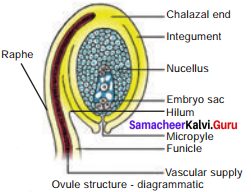
Ovule is also called megasporangium and is protected by one or two covering called integuments. A mature ovule consists of a Raphe stalk and a body. The stalk or the funiculus (also called funicle) is present at the base and it attaches the ovule to the placenta. The point of attachment of funicle to the body of the ovule is known as hilum. It represents the junction ovule and funicle. In an inverted ovule, the funicle is adnate to the body of the ovule forming a ridge called raphe. The body of the ovule is made up of a central mass of parenchymatous tissue called nucellus which has large reserve food materials. The nucellus is enveloped by one or two protective coverings called integuments. Integument encloses the nucellus completely except at the top where it is free and forms a pore called micropyle.
The ovule with one or two integuments are said to be unitegmic or bitegmic ovules respectively. The basal region of the body of the ovule where the nucellus, the integument and the funicle meet or merge is called chalaza. There is a large, oval, sac-like structure in the nucellus toward the micropylar end called embryo sac or female gametophyte. It develops from the functional megaspore formed within the nucellus. In some species(unitegmic tenuinucellate) the inner layer of the integument may become specialized to perform the nutritive function for the embryo sac and is called as endothelium or integumentary tapetum (Example: Asteraceae).
Question 50.
Give a concise account on steps involved in the fertilization of an angiosperm plant.
Answer:
Steps involved in fertilization of angiosperms plant:
- Germination of pollen grain on stigma.
- Formation of pollen tube in stigma.
- Growth of pollen tube inside the style.
- Direction of pollen tube towards the micropyle of ovule.
- Entry of pollen tube into the synergid of embryo sac.
- Discharge of male gametes from the pollen tube.
- Fusion of male gamete with egg cell (syngany)
- Fusion of second male gamete with polar nuclei (triple fusion/double
Question 51.
What is endosperm? Explain the types.
Answer:
1. Endosperm: The primary endosperm nucleus (PEN) divides immediately after fertilization but before the zygote starts to divide, into an endosperm. The primary endosperm nucleus is the result of triple fusion (two polar nuclei and one sperm nucleus) and thus has 3n number of chromosomes. It is a nutritive tissue and regulatory structure that nourishes the developing embryo. Depending upon the mode of development three types of endosperm are recognized in angiosperms. They are nuclear endosperm, cellular endosperm and helobial endosperm.
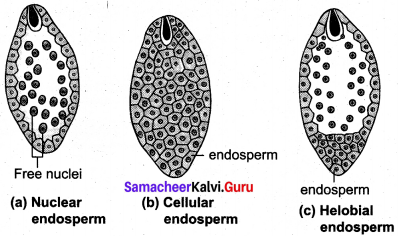
2. Nuclear endosperm: Primary Endosperm Nucleus undergoes several mitotic divisions without cell As, wall formation thus a free nuclear condition exists in the endosperm.
Examples: Coccinia, Capsella and Arachis.
3. Cellular endosperm: Primary endosperm nucleus divides into 2 nuclei and it is immediately followed by wall formation. Subsequent divisions also follow cell wall formation.
Examples: Adoxa, Helianthus and Scoparia.
4. Helobial endosperm: Primary Endosperm Nucleus moves towards base of embryo sac and divides into two nuclei. Cell wall formation takes place leading to the formation of a large micropylar and small chalazal chamber. The nucleus of the micropylar chamber undergoes several free nuclear division whereas that of chalazal chamber may or may not divide.
Examples : Hydrilla and Vallisneria.
5. Ruminate endosperm: The endosperm with irregularity and unevenness in its surface forms ruminate endosperm. Examples : Areca catechu, Passiflora and Myristica
Question 52.
Differentiate the structure of Dicot and Monocot seed
Answer:
Dicot Seed:
- Possess two cotyledons
- Absence of coleoptile and coleorhiza
- Endosperm is scarce or absent
Monocot Seed:
- Possess only one cotyledon
- Presence of coleoptile and colerhiza surrounding plumule and radicle respectively.
- Endosperm from the major storage tissue.

Question 53.
Give a detailed account of parthenocarpy. Add a note on its significance.
Answer:
1. Parthenocarpy
Development of fruit like structures from the ovary without fertilization. These fruits are parthenocarpic fruits. They have no true seeds. Commercially they are seedless fruits.
Genetic Parthenocarpy (Ex. Citrus)
Due to hybridization, Mutation.
Ex: Citrus, Cucurbita
Environmental Parthenocarpy
Environmental condition induces parthenocarpy. Ex) Low temperature for 3-19 hours.
Chemically Induced Parthenocarpy.
Growth promoting Auxins, Gibberellins induce parthenocarpy.
Significance
- Significance of seedless fruits in horticulture.
- Commercial Importance
- To prepare jam, jelly, sauce, fruit drinks.
- A high proportion of edible part due to absence of seed.
Samacheer Kalvi 12th Bio Botany Asexual and Sexual Reproduction in Plants Additional Questions and Answers
1 – Mark Questions
Question 1.
Match the following:
(1) Conidia – (i) Yeast
(2) Budding – (ii) Bacteria
(3) Gemma cups – (iii) Aspergilus
(4) Binary fission – (iv) Marchantia
(a) 1 – (iii), 2 – (i), 3 – (iv), 4 – (ii)
(b) 1 – (ii), 2 – (iv), 3 – (iii), 4 – (i)
(c) 1 – (iv), 2 – (ii), 3 – (i), 4 – (iii)
(d) 1 – (i), 2 – (iii), 3 – (ii), 4 – (iv)
Answer:
(a) 1 – (iii), 2 – (i), 3 – (iv), 4 – (ii)
Question 2.
The unit of reproductive structure used in vegetative propagation is called as
(a) Diplospores
(b) Aplanospores
(c) Diaspores
(d) Condiospores
Answer:
(c) Diaspores
Question 3.
Which of the following aquatic plant is popularly known as the “Terror of Bengal”?
(a) Eichornia crassipes
(b) Vallisneria spiralis
(c) Pistia stratiotes
(d) Zostera marina
Answer:
(a) Eichornia crassipes
Question 4.
Identify the incorrect statement regarding vegetative reproduction.
Answer:
(a) Only one parent is required for propagation.
(b) New individuals are genetically dissimilar.
(c) Easy mode of reproduction.
(d) Variation does not exist.
Answer:
(b) New individuals are genetically dissimilar.
Question 5.
The genetic ability of a plant cell to produce the entire plant is said to be
(a) Multipotency
(b) Totipotency
(c) Pleuripotency
(d) Differentiation
Answer:
(b) Totipotency
Question 6.
A typical anther is
(a) Bisporangiate
(b) Tetrasporangiate
(c) Unisporangiate
(d) Multisporangiate
Answer:
(b) Tetrasporangiate
Question 7.
Match the following:
Vegetative Reproductive structures

(a) 1 – (ii), 2 – (i), 3 – (iv), 4 – (iii)
(b) 1 – (ii), 2 – (iv), 3 – (iii), 4 – (i)
(c) 1 – (iv), 2 – (ii), 3 – (i), 4 – (iii)
(d) 1 – (i), 2 – (iii), 3 – (ii), 4 – (iv)
Answer:
(a) 1 – (ii), 2 – (i), 3 – (iv), 4 – (iii)
Question 8.
Innermost layer of anther wall is
(a) Endothecium
(b) Endothecum
(c) Endothelium
(d) Tapetum
Answer:
(d) Tapetum
Question 9.
Identify the mismatched pair:
(a) Epidermal layer – Protective infunction
(b) Endothecium layer – Helps in dehiscence of anther
(c) Middle layer – Persistent layer
(d) Tapetum – Nutritive in function
Answer:
(c) Middle layer – Persistent layer
Question 10.
Name the person who discovered the pollen tube?
(a) E.Strasburger
(b) Hofineister
(c) Nehemiah Grew
(d) G.B.Amici
Answer:
(d) G.B.Amici
Question 11.
Identify the mismatched pair
(i) Sucker – Chrysanthemum
(ii) Bulbils – Agave
(iii) Stolon – Fragaria
(iv) Runner – Lilium
(a) i only (b) ii only (c) iii only (d) iv only
Answer:
(d) iv only
Question 12.
Assertion (A): Epidermis is protective in function.
Reason (R): Epidermis is outermost unilayer of anther wall.
(a) A is correct R is incorrect.
(b) R explains A.
(c) Both A and R are incorrect.
(d) Both A and R are correct. R does not explain A.
(b) R explains A.
Answer:
(b) R explains A.

Question 13.
Assertion (A) : Microspores are the first cell of male gametophyte.
Reason (R) : Microspores undergo development and forms pollen grains.
(a) A is correct R is incorrect.
(b) R explains A.
(c) Both A and R are incorrect.
(d) Both A and R are correct. R does not explain A.
Answer:
(b) R explains A.
Question 14.
Assertion (A) : Carica papaya is a dioecious plant.
Reason (R): Both male and female flowers are borne on same plant.
(a) A is correct R is incorrect.
(b) R explains A.
(c) Both A and R are incorrect.
(d) Both A and R are correct. R does not explain A.
Answer:
(a) A is correct R is incorrect.
Question 15.
Assertion (A) : Anemophilous pollination occurs by animals.
Reason (R) : Pollen grains are sticky for easy attachment on animals.
(a) A is correct R is incorrect.
(b) R explains A.
(c) Both A and R are incorrect.
(d) Both A and R are correct. R does not explain A.
Answer:
(c) Both A and R are incorrect.
Question 16.
Assertion (A) : Fusion of male and female gametes results in zygote.
Reason (R): Product of triple fusion is PEN.
(a) A is correct R is incorrect.
(b) R explains A.
(c) Both A and R are incorrect.
(d) Both A and R are correct. R does not explain A.
Answer:
(d) Both A and R are correct. R does not explain A.
Question 17.
Assertion (A) : Zea mays is a monocotyledonous plant.
Reason (R) : Shield shaped cotyledon is called scutellum.
(a) A is correct R is incorrect.
(b) R explains A.
(c) Both A and R are incorrect.
(d) Both A and R are correct. R does not explain A.
Answer:
(b) R explain A.
Question 18.
Assertion (A) : In Bryophyllum, vegetative propagation occurs through leaf.
Reason (R) : Epiphyllous buds are noticed in Bryophyllum.
(a) A is correct R is incorrect.
(b) R explains A.
(c) Both A and R are incorrect.
(d) Both A and R are correct. R does not explain A.
Answer:
(b) R explain A.
Question 19.
Assertion (A): Androecium and Gynoecium are essential whorls of flower
Reason (R) : Androecium and Gynoecium assist the reproduction.
(a) A is correct R is incorrect
(b) R explains A
(c) Both A and R are incorrect
(d) Both A and R are correct. R does not explain A
Answer:
(a) A is correct R is incorrect
Question 20.
Identify the correct statement.
(a) Grafting is a modem method of artificial propagation.
(b) The plant which is used for graft is scion.
(c) In tongue grafting, the scion bud is placed inside the incision beneath bark.
(d) Grafting is usually carried out in monocot plants.
Answer:
(b) The plant which is used for graft is scion.
Question 21.
Statement 1: Flower is a highly condensed shoot for reproductive purpose.
Statement 2: A complete flower possess four whorls.
(a) Both the statements are incorrect.
(b) Statement 1 is correct and Statement 2 is incorrect.
(c) Both the statements are correct.
(d) Statement 1 is incorrect and statement 2 is correct.
Answer:
(c) Both the statements are correct.
Question 22.
Identify the incorrect statement.
(a) One seeded fruit of paddy is caryopsis.
(b) Primitive root is called coleorhiza.
(c) Sctellum is a part of monocot seed.
(d) Embryonic axis above the cotyledon is epicotyl.
Answer:
(b) Primitive root is called coleorhiza.
Question 23.
Cleavage polyembryony is noticed in
(a) Orchids
(b) Casuarina
(c) Balanophora
(d) Syzygium
Answer:
(a) Orchids
Question 24.
Pick out the non-spermous seed
(a) Wheat
(b) Sunflower
(c) Bean
(d) Orchids
Answer:
(c) Bean
Question 25.
The type of endosperm noticed in Hydrilla seed
(a) Ruminate endosperm
(b) Nuclear endosperm
(c) Cellular endosperm
(d) Helobial endosperm
Answer:
(b) Nuclear endosperm
Question 26.
Which is note a part of mature seed?
(a) Funiculus
(b) Testa and tegma
(c) hilm
(d) Chalaza
Answer:
(d) Chalaza
Question 27.
Select the wrong statement(s) regarding cross pollination.
(a) Pollination depends on external agent and so it is certain.
(b) New varieties are produced.
(c) Continuous cross pollination leads to weaker progeny.
(d) Germination capacity is highly declined.
(i) a and d
(ii) b and c
(iii) a, b and d
(iv) a, c and d
(iv) a, c and d
Answer:
(iv) a, c and d
Question 28.
Which of the following characters does not exist in Omithophilous flowers?
(a) Huge sized flowers
(b) Bright coloured
(c) Scented flowers
(d) Nectar is secreted in large
Answer:
(c) Scented flowers

Question 29.
Which of the following plant was introduced as a contaminant into India along with wheat?
(a) Parthenium hysterophorus
(b) Zea mays
(c) Rosaindica
(d) Mangifera indica
Answer:
(a) Parthenium hysterophorus
Question 30.
_____ is a carotenoid derivative of exine layer which provides resistance to pollen grains.
Answer:
Sporopollenin
Question 31.
The most common type of ovule noticed in dicots and monocots is ______
(a) Orthotropus
(b) Anatropous
(c) Campylotropus
(d) Amphitropous
Answer:
(b) Anatropous
Question 32.
Identity the incorrect statement.
(а) The stalk of the ovule is funiculus.
(b) Nucellus is composed of sclerenchymatous tissue.
(c) Basal region of the ovule is chalaza end.
(d) Micropyle is always oriented opposite to chalaza.
Answer:
(b) Nucellus is composed of sclerenchymatous tissue.
Question 33.
Generally the pollen grains are liberated from anther at
(a) 2-celled stage
(b) 4-celled stage
(c) 6-celled stage
(d) 8-celled stage
Answer:
(a) 2-celled stage
Question 34.
Assertion (A) : Self – pollination is certain in cleistogamous flowers.
Reason (R) : Flowers never open and do not expose reproductive organs.
(a) Both A and R are incorrect.
(b) A is correct R is incorrect.
(c) R explains A.
(d) Both A and R are correct. R is not correct explanation for A.
Answer:
(c) R explains A.
Question 35.
Assertion (A): Entamophily is the most common type of pollination.
Reason (R) : Birds and animals brings out effective pollination.
(a) Both A and R are incorrect.
(b) A is correct R is incorrect.
(c) R explains A.
(d) Both A and R are correct. R is not a correct explanation for A.
Answer:
(d) Both A and R are correct. R is not a correct explanation for A.
Question 36.
Statement 1: Primary sporogenous cell functions as megaspore mother cell.
Statement 2: Megaspore mother cell undergoes mitotic division producing megaspores.
(a) Statement 1 is correct and statement 2 is incorrect.
(b) Statement 1 is incorrect and statement 2 is correct.
(c) Both the statements 1 and 2 are correct.
(d) Both the statements 1 and 2 are incorrect.
Answer:
(a) Statement 1 is correct and statement 2 is incorrect.
Question 37.
Statement 1: Apomixis does not involve meiosis and syngamy.
Statement 2: The term Apomixis was introduced by Winkler.
(a) Statement 1 is correct and statement 2 is incorrect.
(b) Statement 1 is incorrect and statement 2 is correct.
(c) Both the statements 1 and 2 are correct.
(d) Both the statements 1 and 2 are incorrect.
Answer:
(c) Both the statements 1 and 2 are correct.
Question 38.
Statement 1: The pollen grains are deposited on the receptive surface of style.
Statement 2: After landing, the first visible change in pollen is hydration.
(a) Statement 1 is correct and statement 2 is incorrect.
(b) Statement 1 is incorrect and statement 2 is correct.
(c) Both the statements 1 and 2 are correct.
(d) Both the statements 1 and 2 are incorrect.
Answer:
(b) Statement 1 is incorrect and statement 2 is correct.
Question 39.
Which of the following post fertilization change is incorrectly matched?
(a) Secondary nucellus – Endosperms
(b) Antipodals – Degenerates
(c) Nucellus – Testa and tegma
(d) Funicle – Seed stalk
Answer:
(c) Nucellus – Testa and tegma Identify the parthenocarpic fruit
Question 40.
Identify the parthenocarpic
(a) Banana
(b) Pear
(c) Papaya
(d) More than one option is correct
Answer:
(d) More than one option is correct

Question 41.
A mature angiospermic embryo sac is
(a) 8 celled and 8 nucleated
(b) 7 celled and 8 nucleated
(c) 8 celled and 7 nucleated
(d) 7 celled and 8 nucleated
Answer:
(A) 7 celled and 8 nucleated
Question 42.
Identify the type of ovule, where the nucellus acquires a horse-shoe shaped structure.
(a) Anatropus
(b) Hemianatropus
(c) Campylotropus
(d) Amphitropus
Answer:
(d) Amphitropus
Question 43
(a) 1 egg cell and 2 anti
(b) 1 egg cell and 2 polar nuclei
(c) 1 egg cell and 1 secondary nuycleus
(d) 1 egg cell and 2 synergids
Answer:
(d) 1 egg cell and 2 synergids
Question 44.
Match the following :
(1) Hemianatropous
(2) Circinotropus
(3) Campylotropus
(4) Anatropous
Question 45.
Product of triple fusion is
(a) PEN
(b) PEG
(c) PVC
(d) PPT
Answer:
(a) PEN
Question 46.
Ex-albuminous seeds are
(a) Pea, castor, paddy
(b) Paddy, Coconut, Groundnut
(c) Beans, coconut, castor
(d) Groundnut, pea, beans
Answer:
(d) Groundnut, pea, beans
Question 47.
The white edible part of coconut is…
(a) Epicarp
(b) Endosperm
(c) Embryo
(d) Mesocarp
Answer:
(b) Endosperm
Question 48.
Observe the diagram and select the correct option mentioning the parts A,B,C and D.
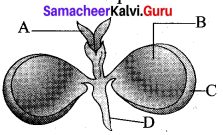

Answer:
(b) (A) Plumule, (B) Cotyledon, (C) Testa, (D) Radicle
Question 49.


Answer:
(d) (A) Hemiamphitropus, (B) Campylotropus, (c) Amphitropus, (d) Circinotropus
Question 50.
Attractants and rewards are required for.
(а) Anemophily
(b) Entamophily
(c) Malacophily
(d) Cheiropterophily
Answer:
(b) Entamophily

Question 51.
Filiform apparatus is a special cellular thickening which is seen in
(a) Antipodals
(b) Polar nuclei
(c) Nucellus
(d) Synergids
Answer:
(d) Synergids
Question 52.
In anatropous ovule, the micropyle faces
(a) Right side
(b) Leftside
(c) Upward
(d) Downward
Answer:
(d) Downward
Question 53.
Observe the diagram and select the correct option mentioning the parts A,B,C and D.
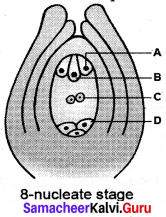

Answer:
(A) Synergid, (B) Egg, (C) polar nuclei, (D) Antipodals
Question 54.
Identify the correct adaptation that checks autogamy
(a) Homogamy
(b) Cleistogamy
(c) Herkogamy
(d) None of the above
Answer:
(c) Herkogamy
Question 55.
In monoecious plants,
(a) Both autogamy and geitonogamy are prevented
(b) Both autogamy and geitonogamy are takes place
(c) Autogamy takes place preventing geitonogamy
(d) Autogamy is prevented whereas geitonogamy takes place
Answer:
(d) Autogamy is prevented whereas geitonogamy takes place
Question 56.
Antipodals are located at of embryo sac.
Answer:
Chalazal end
Question 57.
Identify the correct sequence of anther wall layers from periphery towards core part.
(a) Epidermis → endothelium → stomium → tapetum
(b) Epidermis → middle layer → endothecium → endothelium
(c) Epidermis → endothelium → middle layers → tapetum
(d) Epidermis → endothelium → endothecium → tapetum
Answer:
(c) Epidermis → endothelium → middle layers → tapetum
Question 58.
The proteins responsible for rejection reaction present in exine cavities of pollen is a- derivative of.
(a) Stomium
(b) Endothecium
(c) Tapetum
(d) Ubisch bodies
Answer:
(c) Tapetum
Question 59.
Pick out the mismatched pair:
(a) Entamophily – Insects
(b) Malacophily – Mammals
(c) Cheiropterophily – Bats
(d) Omithophily – Birds
Answer:
(b) Malacophily – Mammals
Question 60.
Which is the most common type of style seen in monocots?
(a) Open type
(b) Closed type
(c) Solid type
(d) Half closed type
Answer:
(a) Open type
2 – Mark Questions
Question 1.
Write the names of organisms that undergo the following types of asexual reproduction.
(a) Budding
(b) fragmentation
(c) Regeneration
(d) Gemma cup formation.
Answer:
(a) Budding – Hydra
(b) Fragmentation – Spirogyra
(c) Regeneration – Planaria
(d) Gemma cup formation – Marchantia

Question 2.
What are diaspores?
Answer:
The unit of reproductive structures used in vegetative propagation is called diaspore or reproductive propagules.
Question 3.
Name the vegetative propagules of the following plants.
(a) Allium cepa
(b) Zingiber officinalis
(c) Agave
(d) Colocasia
Answer:
(a) Allium cepa – Bulb
(b) Zingiber officinalis – Rhizome
(c) Agave – Bulbils
(d) Colocasia – Corm
Question 4.
Point out the advantages of natural vegetative reproduction.
Answer:
(a) Only one parent is required.
(b) New individuals are genetically similar
(c) Rapid spreading
(d) Large scale production
Question 5.
Mention any two conventional propagation techniques.
Answer:
(a) Cutting
(b) Grafting.
Question 6.
What do you mean by terms‘stock’and‘scion’in grafting technique?
Answer:
In Grafting, parts of two different plants are joined so that they continue to grow as one plant. Of the two plants, the plant which is in contact with the soil is called stock and the plant used for grafting is called scion.
Question 7.
Name any four types of grafting.
Answer:
(a) Bud grafting
(b) Tongue grafting
(c) Crown grafting
(d) Wedge grafting
Question 8.
Define totipotency.
Answer:
The genetic ability of a plant cell to produce the entire plant under suitable conditions is said to be totipotency.
Question 9.
What are the term micropropogation refers to?
Answer:
The regeneration of a whole plant from single cell, tissue or small pieces of vegetative structures through tissue culture is called micropropagation. It is one of the modem methods used to propagate plants.
Question 10.
Name the four whorls of a typical flower.
Answer:
(a) Calyx
(b) Corolla
(c) Androecium
(d) Gynoecium
Question 11.
Write any four valid points on Androecium
Answer:
(a) Androecium is the male part of a flower
(b) It is made up of stamens
(c) Each stamen possess anther and a filament
(d) Anthers bear pollen grains (male gametophyte)
Question 12.
What is poilinium? Give example.
Answer:
In some plants, all the microspores in a microsporangium remain held together called poilinium.
Example: Calotropis.
Question 13.
Name the four anther wall layers.
Answer:
(a) Epidermis
(b) Endothecium
(c) Middle layers
(d) Tapetum

Question 14.
Tapetum is dual in origin – Justify.
Answer:
Tapetum is derived partly from peripheral anther wall layer and partly from the connective tissue of anther lining the anther locule. Hence it is said to dual in origin.
Question 15.
Name the two types of tapetum. Mention any one function of tapetum.
Answer:
Tapetum are of two types. Secretory tapetum and Invasive tapetum. Tapetum nourishes the pollen grains.
Question 16.
Differentiate between Exine and Intine layers of pollen grain.
Answer:
Exine:
- Thick outer layers
- It is made of cellulose, sporopollenin and pollenkitt.
- Ununiform layer
Intine:
- Thin inner layer
- It is made up of pectin, hemicellulose, cellulose and callose
- Uniform layer
Question 17.
What are the chemical components that make up the wall layers of pollen grains?
Answer:
Pectin, cellulose, hemicellulose, callose, sporopollenin, pollenkitt and other proteins.
Question 18.
Draw and label the structure of a typical pollen grain
Answer:

Question 19.
At which cellular stage, does the pollen grains are usually liberated from anther? What happens to the generative cell if the pollen reaches the stigma?
Answer:
In general, the pollen grains are liberated at 2 – celled stage. On reaching the stigma at this stage, the generative cell divides meiotically and form two male gametes (male cells)
Question 20.
Write the equivalent botanical terms for the following words / sentences.
(a) Landing platform of pollen
(b) Ovarian cavity
(c) Megasporangium
(d) Basal swollen part of pistil
Answer:
(a) Stigma
(b) Locule
(c) Ovule
(d) Ovary
Question 21.
What is Nucellus?
Answer:
The body of the ovule is made up of a central mass of parenchymatous tissue called nucellus which has large reserve food materials.
Question 22.
What is integumentary tapetum?
Answer:
In Asteraceae species, the inner layer of integument get specialized for nourishing the embryosac and this is called integumentary tapetum or endothelium.
Question 23.
Mention the types of ovule seen in the members of
Answer:
(a) Cactaceae
(b) Leguminosae
(c) Polygonaceae
(d) Primulaceae.
Answer:
(a) Cactaceae – Circinotropous ovule
(b) Leguminosae – Campylotropous ovule
(c) Polygonaceae – Orthotropous ovule
(d) Primulaceae. – Hemianatropous ovule
Question 24.
What does the term ‘Bisporic development of embryo sac’ refers to? Give example.
Answer:
In gynoecium, out of four megaspores formed, if two are involved in embryo sac formation then it is said to be bisporic embryo sac. E.g. Peperomia
Question 25.
State the role of filiform apparatus found in embryo sac of angiosperm.
Answer:
(a) Filiform apparatus helps in absorption conduction of nutrients from nucellus to embryo sac
(b) It guides the pollen tube into the egg.
Question 26.
What is pollination? Mention its types.
Answer:
The process of transfer of pollen grains from the anther to a stigma of a flower is called pollination. The pollination is classified into two kinds, namely, self-pollination (Autogamy) and cross pollination(Allogamy).

Question 27.
Why pollination in gymnosperm is said to be direct?
Answer:
Pollination in gymnosperms is said to be direct as the pollens are deposited directly on the exposed ovules.
Question 28.
Define Homogamy with an example
Answer:
When the stamens and stigma of a flower mature at the same time it is said to be homogamy. It favours self-pollination to occur. Example: Mirabilis jalapa.
Question 29.
What is cross – pollination? What are its types?
Answer:
Cross – pollination refers to the transfer of pollens on the stigma of another flower.
The cross-pollination is of two types:
- Geitonogamy
- Xenogamy.
Question 30.
Distinguish between monoecious and dioecious plants.
Answer:
Monoecious:
Male & Female flowers develop on the same plant.
E.g: Maize
Dioecious:
Male and Female flowers develop on different plants.
E.g: Papaya
Question 31.
Define the following terms.
(a) Protandry
(b) Protogyny
Answer:
(a) Protandry: The stamens mature earlier than stigma. E.g: Helianthus
(b) Protogyny: The stigma mature earlier than stamens. E.g: Aristolochia bracteata
Question 32.
What is Heterostyly? Give example.
Answer:
Heterostyly: Some plants produce two or three different forms of flowers that are different in their length of stamens and style. Pollination will take place only between organs of the same length. E.g: Primula.
Question 33.
How self-pollination is avoided in Abutilon?
Answer:
In Abutilon, the self-pollination is avoided by self sterility or self-incompatibility, in which if the pollen grain reaches the stigma of the same flower, it will be prevented from germination. It is a genetic mechanism.
Question 34.
Name the agents of the following types of pollination
(a) Anemophily
(b) Ornithophily
(c) Cheiropterophily
(d) Malacophily
Answer:
(a) Winds
(b) Birds
(c) Bats
(d) Snails and slugs
Question 35.
Give any four unique characters exhibited by anemophilous flowers.
Answer:
(a) Flowers are small and inconspicuous
(b) Colourless
(c) Non-scented
(d) No nectar secretion
Question 36.
How the pollen grains of Vallisneria protect themselves?
Answer:
Vallisneria is an aquatic plant. Pollen grains of vallisneria are covered by mucilage coating which protects them from wetting.
Question 37.
Point out the differences between anemophilous flowers and ornithophilous flowers.
Answer:
| Anemophilous Flowers |
Ornithophilous Flowers |
| (a) Small sized flowers |
Large sized flowers |
| (b) Colourless |
Brightly coloured |
| (c) Donor produce nectar |
Produce large quantity of nectar |
| E.g: Grasses |
Bombax |
Question 38.
Mention any two disadvantages of self-pollination.
Answer:
- Continuous self-pollination, generation after generation results in weaker progeny.
- Chances of producing new species and varieties are meager.
Question 39.
What is pollen-pistil interaction?
Answer:
The events from pollen deposition on the stigma to the entry of pollen tube in to the ovule is called pollen – pistil interaction. It is a dynamic process which involves recognition of pollen and to promote or inhibit its germination and growth.
Question 40.
What are the major post fertilization events in a flower?
Answer:
Endosperm development, embryo development, seed formation and fruit formation.

Question 41.
What is perisperm? Give example.
Answer:
In some plants, the nucellar tissue is not utilized by the embryo completely, a small portion will remain as a storage tissue in the seed, which is called as perisperm.
E.g: Black Pepper.
Question 42.
What happens to the following floral parts, after the fertilization process?
(a) Ovary
(b) Secondary nucleus
(c) Outer integument of ovule
(d) Funicle
Answer:
(a) Ovary → Fruit
(b) Secondary nucleus → Endosperm
(c) Outer integument of ovule → Outer seed coat (Testa)
(d) Funicle → Stalk of the seed
Question 43.
What is the product of triple fusion? Mention its ploidy.
Answer:
The product of triple fusion is Primary Endosperm Nucleus (PEN). It is triploid (3n) in condition.
Question 44.
Coconut is an albmunious seed. Why?
Answer:
Since coconut seed possess endosperm, it is called as albmunious seed. Endosperm nourishes the embryo during seed germination.
Question 45.
Name the various types of endosperms.
Answer:
(a) Nuclear Endosperm
(b) Helobial Endosperm
(c) Cellular Endosperm
(d) Ruminate Endosperm
Question 46.
What is scutellum?
Answer:
In monocot seeds, the embryo is small and consists of single shield-shaped cotyledon known as scutellum present towards lateral side of embryonal axis.
Question 47.
What is coleoptile and coleorhiza?
Answer:
In monocot embryo, the plumule is covered by a protective sheath called coleoptile and the radicle along with root cap is covered by a protective sheath called coleorhiza.
Question 48.
Who coined the term Apomixis? Define it.
Answer:
The term Apomixis was introduced by Winkler in the year 1908. It is defined as the substitution of the usual sexual system (Amphimixis) by a form of reproduction which does not involve meiosis and syngamy.
Question 49.
What are parthenocarpic fruits?
Answer:
In some plants, fruits develop from ovary without fertilization process. Such fruits are called parthenocarpic fruits. They lack true seeds.
E.g: Grapes.
3 – Mark Questions
Question 50.
How tongue grafting differs from wedge grafting?
Answer:
Tongue grafting:
In tongue grafting A scion and stock having the same thickness is cut obliquely and the scion is fit into the stock and bound with a tape.
Wedge grafting:
In wedge grafting a slit is made in the stock or the bark is cut. A twig of scion is inserted and tightly bound so that the cambium of the two is joined.

Question 51.
List any three advantages of micropropagation.
Answer:
- Tissue culture can be carried out in any season to produce plants.
- Plants which do not produce viable seeds and seeds that are difficult to germinate can be propagated by tissue culture.
- Cells can be genetically modified and transformed using tissue culture.
Question 52.
Where the stomium is located? What is its role?
Answer:
In a mature anther, the cells along with junction or the two sporangia of an anther lobe lack cellulose and lignin thickening. This region is called stomium. Stomium along with hygroncopic nature of Endothecium helps in the dehiscence of anther at maturity.
Question 53.
Briefly explain about the types of tapetum.
Answer:
There are two types of tapetum based on its behaviour.
They are:
Secretory tapetum (parietal/glandular/ cellular): The tapetum retains the original position hnd cellular integrity and nourishes the developing microspores.
Invasive tapetum (periplasmodial): The cells loose their inner tangential and radial walls and the protoplast of all tapetal cells coalesces to form a periplasmodium.
Question 54.
Enumerate the functions of tapetum.
Answer:
- It supplies nutrition to the developing microspores.
- It contributes sporopollenin through ubisch bodies thus plays an important role in pollen wall formation.
- The pollenkitt material is contributed by tapetal cells and is later transferred to the pollen surface.
- Exine proteins responsible for ‘rejection reaction’ of the stigma are present in the cavities of the exine. These proteins are derived from tapetal cells.
Question 55.
State the significance of sporopollenin.
Answer:
The wall material sporopollenin is contributed by both pollen cytoplasm and tapetum. It is derived from carotenoids. It is resistant to physical and biological decomposition. It helps to withstand high temperature and is resistant to strong acid, alkali and enzyme action. Hence, it preserves the pollen for long periods in fossil deposits, and it also protects pollen during its journey from anther to stigma.
Question 56.
What do you know about bee pollen?
Answer:
- Bee pollen is a natural substance with high proteins, carbohydrate and trace amount of vitamins and minerals.
- It is used as dietary supplement as tablets.
- It increases performance of athletes, race horses and also heals bum wounds.
Question 57.
Write a note on pollenkitt.
Answer:
Pollenkitt is contributed by the tapetum and coloured yellow or orange and is chiefly made of carotenoids or flavonoids. It is an oily layer forming a thick viscous coating over pollen surface. It attracts insects and protects damage from UV radiation.
Question 58.
Draw and label the structure of a mature embryo sac of angiosperm.
Answer:
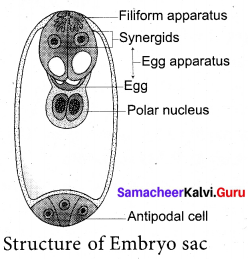
Question 59.
How many synergid cells are there in an mature embryo sac. Mention any two major role of synergids.
Answer:
The egg apparatus possess two synergids.
Synergids secrete chemotropic substances that attracts the pollen tube.
Synergids also guides the pollen tube into the egg.
Question 60.
A mature female gametophyte (embryo sac / egg apparatus) of angiosperms is 7 celled with 8 nucleus. Name the individual cells and mention their count.
Answer:
(a) Egg – 1
(b) Secondary nucleus – 1
(c) Synergids – 2
(d) Antipodalcells – 3
Question 61.
Differentiate between chasmogamy and cleistogamy
Answer:
Chasmogamy:
- In chasmogamy, the flowers opens and express its mature anthers and stigma for pollination.
- Self-pollination is uncertain
- Depend on pollinating agents
- Example: Hibiscus
Cleistogamy:
- In cleistogamy the pollination occurs without opening of flowers and exposing their sex organs.
- Self pollination is certain.
- No need of pollinating agents.
- Example: Commelina
Question 62.
Geitonogamy is similar to autogamy. Justify the statement.
Answer:
When the pollen deposits on another flower of the same individual plant, it is said to be geitonogamy. It usually occurs in plants which show monoecious condition. It is functionally cross-pollination but is similar to autogamy because the pollen comes from same plant.
Question 63.
Explain the Herkogamy mechanism with suitable examples.
Answer:
In bisexual flowers the essential organs, the stamens and stigmas, are arranged in such a way that self-pollination becomes impossible. For example in Gloriosa superba, the style is reflexed away from the stamens and in Hibiscus the stigmas project far above the stamens.
Question 64.
Give a brief account on pollination process in Zea mays.
Answer:
The maize is monoecious and unisexual. The male inflorescence (tassel) is borne terminally and female inflorescence (cob) laterally at lower levels. Maize pollens are large and heavy and cannot be carried by light breeze. However, the mild wind shakes the male inflorescence to release the pollen which falls vertically below. The female inflorescence has long stigma (silk) measuring upto 23 cm in length, which projects beyond leaves. The pollens drop from the tassel is caught by the stigma.
Question 65.
Explain the role of water as a pollinating agent in Vallisneria spiralis.
Answer:
Pollination in Vallisneria spiralis: It is a dioecious, submerged and rooted hydrophyte. The female plant bears solitary flowers which rise to the surface of water level using a long coiled stalk at the time of pollination. A small cup shaped depression is formed around the female flower on the surface of the water.
The male plant produces male flowers which get detached and float on the surface of the water. As soon as a male flower comes in closer to a female flower, it gets settled in the depression and contacts with the stigma thus bringing out pollination. Later the stalk of the female flower coils and brings back the flower from surface to under water where fruits are produced.
Question 66.
Enumerate the characters of ornithophilous flowers.
Answer:
The ornithophilous flowers have the following characteristic features:
- The flowers are usually large in size.
- The flowers are tubular, cup shaped or um- shaped.
- The flowers are brightly coloured, red, scarlet, pink, orange, blue and yellow which attracts the birds.
- The flowers are scentless and produce nectar in large quantities. Pollen and nectar form the floral rewards for the birds visiting the flowers.
- The floral parts are tough and leathery to withstand the powerful impact of the visitors.

Question 67.
How the flowers of salvia are adopted for mellitophily?
Answer:
Pollination in Salvia (Lever mechanism): The flower of Salvia is adapted for Bee pollination. The flower is protandrous and the corolla is bilabiate with 2 stamens. A lever mechanism helps in pollination. Each anther has an upper fertile lobe and lower sterile lobe which is separated by a long connective which helps the anthers to swing freely. When a bee visits a flower, it sits on the lower lip which acts as a platform. It enters the flower to suck the nectar by pushing its head into the corolla.
During the entry of the bee into the flower the body strikes against the sterile end of the connective. This makes the fertile part of the stamen to descend and strike at the back of the bee. The pollen gets deposited on the back of the bee. When it visits another flower, the pollen gets rubbed against the stigma and completes the act of pollination in Salvia.
Question 68.
Mention any three advantages of cross pollination.
Answer:
- It always results in bringing out much healthier off springs.
- Germination capacity is much better.
- New varieties may be produced.
- The adaptability of the plants to their environment is better.
Question 69.
Why pollination has to occur?
Answer:
- Pollination is a pre-requisite for the process of fertilisation. Fertilisation helps in the formation of fruits and seeds.
- It brings the male and female gametes closer for the process of fertilisation.
- Cross-pollination introduces variations in plants due to the mixing up of different genes. These variations help the plants to adapt to the environment and results in speciation.
Question 70.
How the pollen germination and compatability is regulated by stigma of Gynoecium?
Answer:
The receptive surface of the stigma receives the pollen. If the pollen is compatible with the stigma it germinates to form a tube. This is facilitated by the stigmatic fluid in wet stigma and pellicle in dry stigma. These two also decide the incompatibility and compatibility of the pollen through recognition-rejection protein reaction between the pollen and stigma surface.
Question 71.
Give a brief account on solid style.
Answer:
It is common among dicots. It is characterized by the presence of central core of elongated, highly specialised cells called transmitting tissue.This is equivalent to the lining cells of hollow style and does the same function. Its contents are also similar to the content of those cells. The pollen tube grows through the intercellular spaces of the transmitting tissue.
Question 72.
What are the ways through which the pollen tube enters into ovule? Explain.
Answer:
Entry of pollen tube into the ovule: There are three types of pollen tube entry into the ovule.
Porogamy: when the pollen tube enters through the micropyle.
Chalazogamy: when the pollen tube enters through the chalaza.
Mesogamy: when the pollen tube enters through the integument.
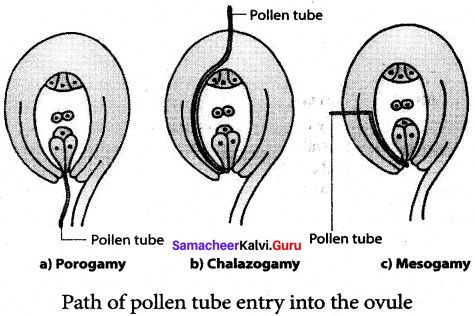
Question 73.
What is the fate of pollen tube after reaching the embryo sac?
Answer:
After reaching the embryo sac, a pore is formed in pollen tube wall at its apex or just behind the apex. The content of the pollen tube (two male gametes, vegetative nucleus and cytoplasm) are discharged into the synergids into which pollen tube enters. The pollen tube does not grow beyond it, in the embryo sac. The tube nucleus disorganizes.
Question 74.
Double fertilization and triple fusion are correlated terms. Comment.
Answer:
The two male gametes released from a male gametophyte are involved in the fertilization. They fertilize two different components of the embryo sac. Since both the male gametes are involved in fertilization, the phenomenon is called double fertilization and is unique to angiosperms. One of the male gametes fuses with the egg nucleus (syngamy) to form , Zygote.
The second gamete migrates to the central cell where it fuses with the polar nuclei or their fusion product, the secondary nucleus and forms the primary endosperm nucleus (PEN). Since this involves the fusion of three nuclei, this phenomenon is called triple fusion. This
act results in endosperm formation which forms the nutritive tissue for the embryo.
Question 75.
Write a short note on endosperm.
Answer:
The primary endosperm nucleus (PEN) divides immediately after fertilization but before 1 the zygote starts to divide, into an endosperm. The primary endosperm nucleus is the result of triple fusion (two polar nuclei and one sperm nucleus) and thus has 3n number of chromosomes. It is a nutritive tissue and regulatory structure that nourishes the developing embryo. Depending upon the mode of development three types of endosperm are recognized in angiosperms. They are nuclear endosperm, cellular endosperm and helobial endosperm.

Question 76.
How nuclear endosperm is different from cellular endosperm.
Answer:
Nuclear endosperm:
Nuclear endosperm: Primary Endosperm Nucleus undergoes several mitotic divisions without cell wall formation thus a free nuclear condition exists in the endosperm.
Examples: Coccinia, Capsella and Arachis.
Cellular endosperm:
Cellular endosperm: Primary endosperm nucleus divides into 2 nuclei and it is immediately followed by wall formation. Subsequent divisions also follow cell wall formation.
Examples: Adoxa, Helianthus and Scoparia.
Question 77.
Give an account on Helobial endosperm.
Answer:
Helobial endosperm: Primary Endosperm Nucleus moves towards base of embryo sac and divides into two nuclei. Cell wall formation takes place leading to the formation of a large micropylar and small chalazal chamber. The nucleus of the micropylar chamber undergoes several free nuclear division whereas that of chalazal chamber may or may not divide.
Examples : Hydrilla and Vallisneria.
Question 78.
Differentiate between albuminous seed and ex-albuminous seed.
Answer:
Albuminous Seed:
The seeds with endosperm are called albuminous seed of endospermous seeds.
E.g: Coconut
Ex-albuminous Seed:
The seeds without endosperm are called ex-albuminous seeds or non-endospermous seeds.
E.g: Beans
Question 79.
Draw and label the structure of nuclear endosperm and Helobial endosperm
Answer:
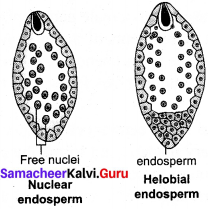
Question 80.
Point out the function of endosperm.
Answer:
Functions of endosperm:
- It is the nutritive tissue for the developing embryo.
- In majority of angiosperms, the zygote divides only after the development of endosperm.
- Endosperm regulates the precise mode of embryo development.
Question 81.
What are the components of mature dicot embryo.
Answer:
The mature dicot embryo has a radicle, two cotyledons and a plumule.
Question 82.
What is apospory?
Answer:
Megaspore mother cell undergoes the normal meiosis and four megaspores formed gradually disappear. A nucellar cell becomes activated and develops into a diploid embryo sac. This type of apospory is also called somatic apospory. Examples Hieracium and Parthenium.
5 – Mark Questions
Question 83.
Give a comperative account on Anther wall layers.
Answer:
Anther wall : The mature anther wall consists of the following layers
a. Epidermis
b. Endothecium
c. Middle layers
d. Tapetum.
a. Epidermis: It is single layered and protective in function. The cells undergo repeated anticlinal divisions to cope up with the rapidly enlarging internal tissues.
b. Endothecium: It is generally a single layer of radially elongated cells found below the epidermis. The inner tangential wall develops bands (sometimes radial walls also) of a cellulose (sometimes also slightly lignified). The cells are hygroscopic. In the anthers of aquatic plants, saprophytes, cleistogamous flowers and extreme parasites endothecial differentiation is absent. The cells along the junction of the two sporangia of an anther lobe lack these thickenings. This region is called stomium. This region along with the hygroscopic nature of endothecium helps in the dehiscence of anther at maturity.
c. Middle layers: Two to three layers of cells next to endothecium constitute middle layers. They are generally ephemeral. They disintegrate or get crushed during maturity.
d. Tapetum: It is the innermost layer of anther wall and attains its maximum development at the tetrad stage of microsporogenesis. It is derived partly from the peripheral wall layer and partly from the connective tissue of the anther lining the anther locule. Thus, the tapetum is dual in origin. It nourishes the developing sporogenous tissue, microspore mother cells andmicrospores.
The cells of the tapetum may remain uninucleate or may contain more than one nucleus or the nucleus may become polyploid. It also contributes to the wall materials, sporopollenin, pollenkitt, tryphine and number of proteins that control incompatibility reaction .Tapetum also controls the fertility of sterility of the microspores or pollen grains.

Question 84.
Explain the development process of male gametophyte.
Answer:
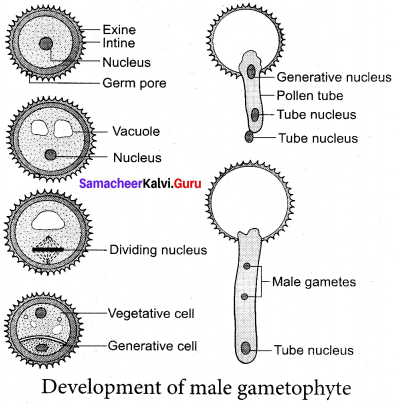
The microspore is the first cell of the male gametophyte and is haploid. The development of male gametophyte takes place while they are still in the microsporangium.
The nucleus of the microspore divides to form a vegetative and a generative nucleus. A wall is laid around the generative nucleus resulting in the formation of two unequal cells, a large irregular nucleus bearing with abundant food reserve called vegetative cell and a small generative cell. At this 2 celled stage, the pollens are liberated from the anther. In some plants the generative cell again undergoes a division to form two male gametes. In these plants,
the pollen is liberated at 3 celled stage. In 60% of the angiosperms pollen is liberated in 2 celled stage. Further, the growth of the male gametophyte occurs only if the pollen reaches the right stigma. The pollen on reaching the stigma absorbs moisture and swells.
The inline grows as pollen tube through the germ pore. Incase the pollen is liberated at 2 celled stage the generative cell divides in the pollen into 2 male cells (sperms) after reaching the stigma or in the pollen tube before reaching the embryo sac.
Question 85.
Explain any five types of angiospermic ovules.
Answer:
Orthotropous: In this type of ovule, the micropyle is at the distal end and the micropyle, the funicle and the chalaza lie in one straight vertical line. Examples: Piperaceae, Polygonaceae
Anatropous: The body of the ovule becomes completely inverted so that the micropyle and funiculus come to lie very close to each other. This is the common type of ovules found in dicots and monocots.

Hemianatropous: In this, the body of the ovule is placed transversely and at right angles to the funicle. Example: Primulaceae.
Campylotropous: The body of the ovule at the micropylar end is curved and more or less bean shaped. The embryo sac is slightly curved. All the three:, hilum, micropyle and chalaza are adjacent to one another, with the micropyle oriented towards the placenta.
Example: Leguminosae.
Amphitropous: The distance between hilum and chalaza is less. The curvature of the ovule leads to horse-shoe shaped nucellus.
Example: some Alismataceae.
Question 86.
Describe the development of monrosporic embryo sac.
Answer:
The functional megaspore is the first cell of the embryo sac or female gametophyte. The megaspore elongates along micropylar- chalazal axis. The nucleus undergoes a mitotic division. Wall formation does not follow the nuclear division. A large central vacuole now appears between the two daughter nuclei.
The vacuole expands and pushes the nuclei towards the opposite poles of the embryo sac. Both the nuclei divide twice mitotically, forming four nuclei at each pole. At this stage all the eight nuclei are present in a common cytoplasm (free nuclear division). After the last nuclear division the cell undergoes appreciable elongation, assuming a sac-like appearance. This is followed by cellular organization of the embryo sac. Of the four nuclei at the micropylar end of the embryo sac, three organize into an egg apparatus, the fourth one is left free in the cytoplasm of the central cell as the upper polar nucleus.
Three nuclei of the chalazal end form three antipodal cells whereas the fourth one functions atk the lower polar nucleus. Depending on the plant the 2 polar nuclei may remain free or iftiay fuse to form a secondary nucleus , (central cell). The egg apparatus is made up of a central egg celkand two synergids, one on each side of the egg cell. Synergids secrete chemotropic substances that help to attract the pollen tube. The special cellular thickening called filiform apparatus of synergids help in the absorption, conduction of nutrients from the nucellus to embryo sac. It also guides the pollen tube into the egg. Thus, a 7 celled with 8 nucleated embryo sac is formed.
Question 87.
Enumerate the characters of anemophilous flowers Anemophilous plants have the following characteristic features:
Answer:
- The flowers are produced in pendulous, catkin-like or spike inflorescence.
- The axis of inflorescence elongates so that the flowers are brought well above the leaves.
- The perianth is absent or highly reduced.
- The flowers are small, inconspicuous, colourless, not scented, do not secrete nectar.
- The stamens are numerous, filaments are long, exerted and versatile.
- Anthers produce enormous quantities of pollen grains compared to number of ovules available for pollination. They are minute, light and dry so that they can be carried to long distances by wind.
- In some plants anthers burst violently and release the pollen into the air. Example: Urtica.
- Stigmas are comparatively large, protruding, sometimes branched and feathery, adapted to catch the pollen grains. Generally single ovule is present.
- Plant produces flowers before the new leaves appear, so the pollen can be carried without hindrance of leaves.
Question 88.
Describe the structure of a dicot seed.
Answer:
Structure of a Cicer seed as an example for Dicot seed The mature seeds are attached to the fruit wall by a stalk called funiculus. The funiculus disappears leaving a scar called hilum. Below the hilum a small pore called micropyle is present. It facilitates entry of oxygen and water into the seeds during germination. Each seed has a thick outer covering called seed coat. The seed coat is developed from integuments of the ovule. The outer coat is called testa and is hard whereas the inner coat is thin, membranous and is called tegmen.
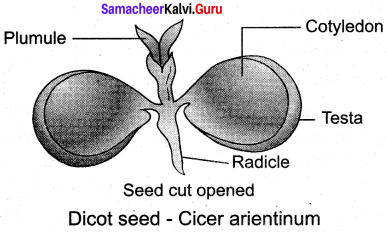
In Pea plant the tegmen and testa are fused. Two cotyledons laterally attached to the embryonic axis are present. It stores the food materials in pea whereas in other seeds like castor the endosperm contains reserve food and the cotyledons are thin. The portion of embryonal axis projecting beyond the cotyledons is called radicle or embryonic root. The other end of the axis called embryonic shoot is the plumule.
Embryonal axis above the level of cotyledon is called epicotyl whereas the cylindrical region between the level of cotyledon is called hypocotyl. The epicotyl terminates in plumule whereas the hypocotyl ends in radicle.
Higher Order Thinking Skills (HOTs) Questions
Question 1.
Cleistogamous flower and chasmogamous flower. In which type does the autogamy is certain? Why?
Answer:
Autogamy is certain in cleistogamous flowers since they never open and expose the reproductive organs.
Question 2.
Position of essential whorls and inhibition of autogamy in Gloriosa superba – comment.
Answer:
In the bisexual flowers of Gloriosa superba, the style of the gynoecium is reflexed away from the stamens assuring that self-pollination (autogamy) is impossible.

Question 3.
Anemophilous flowers produce abundant pollen grains. Give reason.
Answer:
Anemophily is a chance event. The liberated pollen may or may not reach the target flower and are wasted during the transmission from one flower to another. Hence enormous pollen grains are produced to assure pollination.
Question 4.
Observe the picture and answer the questions.
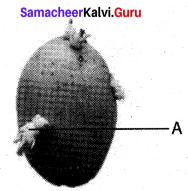
(а) Label the part – A
(b) Name the types of vegetative propagule
(c) Give one example for such type of vegetative propagule.
Answer:
(a) A – Bud from eye
(b) Tuber
(c) Solanum tuberosum
Question 5.
Arrange the following events in a proper sequence.
Embryogenesis, Zygote formation, Syngamy, Gametogenesis
Answer:
Gametogenesis → Syngamy → Zygote formation → Embryogenesis
Question 6.
Name the process through which microspore tetrads are formed. What would be the ploidy of the cells of terad?
Answer:
Microspores are formed by the process of microsporogenesis. The cells of microspore tetrad are haploid(n).
Question 7.
Anemophilous flowers are colourless and non-scented. What may be the reason?
Answer:
Production of coloured and scented flowers are to attract the pollinating agents. Where as wind acts as a pollinating agent for anemophilous flowers. Hence it is unnecessory to produce coloured and scented flowers.
Question 8.
If you break open the coconut fruit, we can observe a fluid part and the white kernel.What does those parts represent?
Answer:
The fluid part of the coconut represents free-nuclear endosperm and the white kernel represents cellular endosperm.
Question 9.
Cite one common feature and one contrast feature shared between apomixis and parthenocarpy
Answer:
Common features : Fertilization (Syngamy) is absent in both apomixis and parthenocarpy.
Contrast features : Parthenocarpic fruits does not develop seeds, whereas in apomixis seeds are developed.
![]()
![]()
![]()
![]()
![]()
![]()
![]()
![]()
![]()
![]()
![]()

![]()







![]()
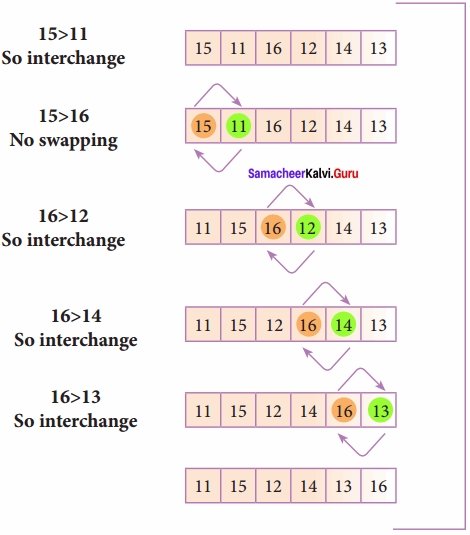

![]()
![]()

![]()
![]()
![]()
![]()
![]()
![]()
![]()
![]()
![]()

![]()
![]()
![]()
![]()
![]()
![]()
![]()
![]()
![]()
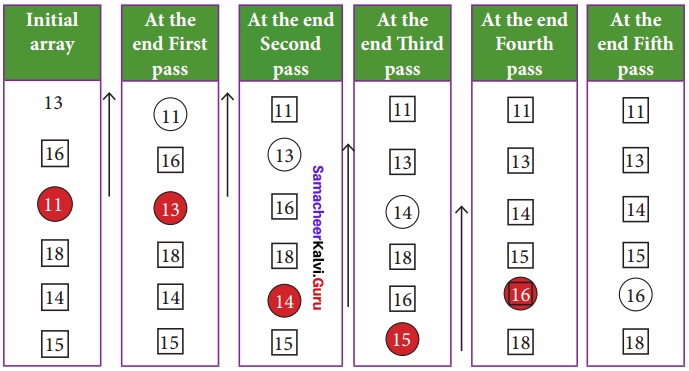
![]()
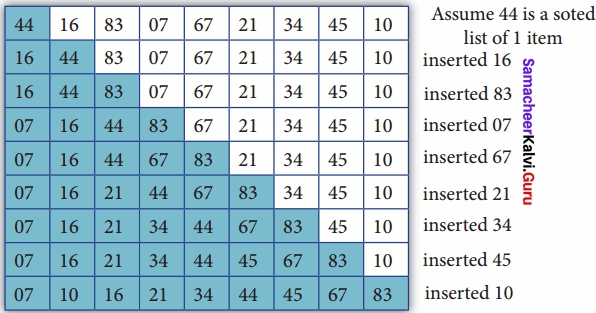
![]()

















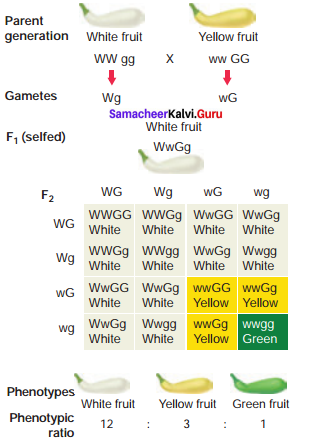
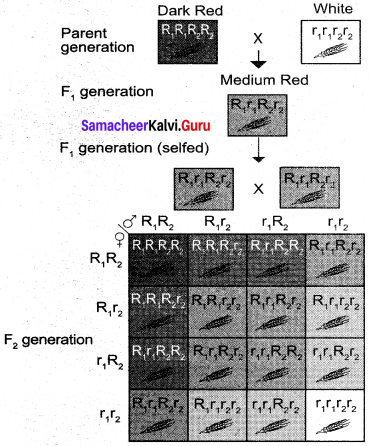
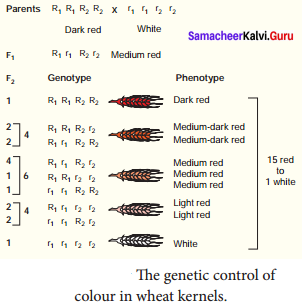
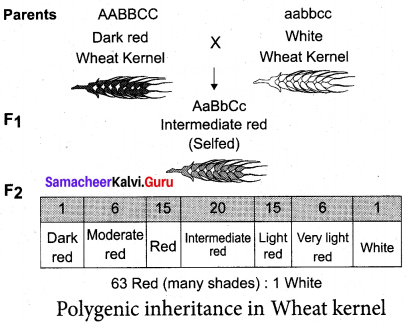
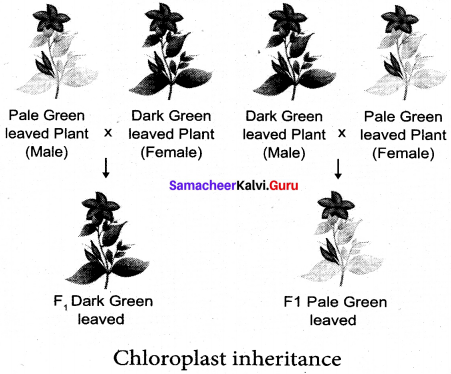


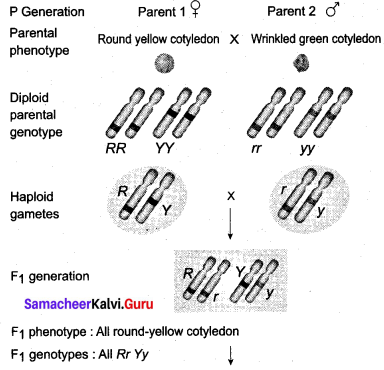
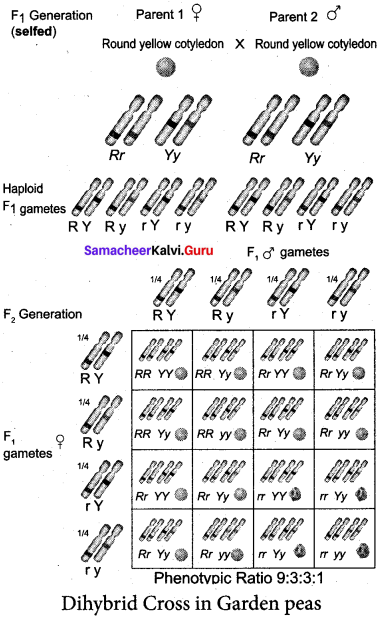
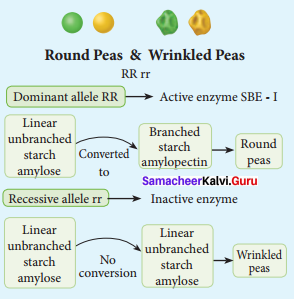
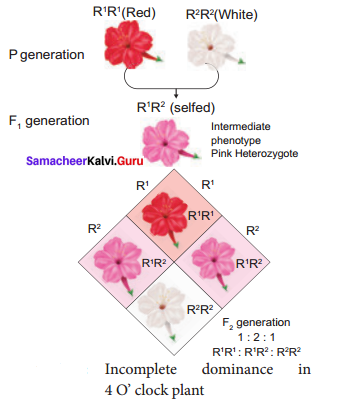
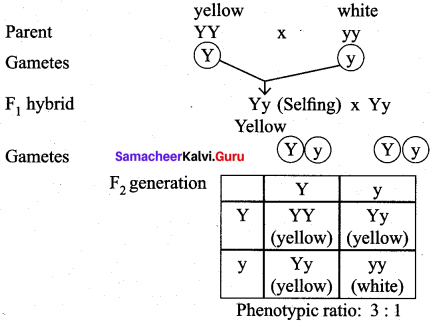
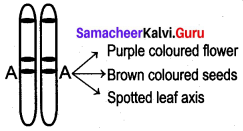
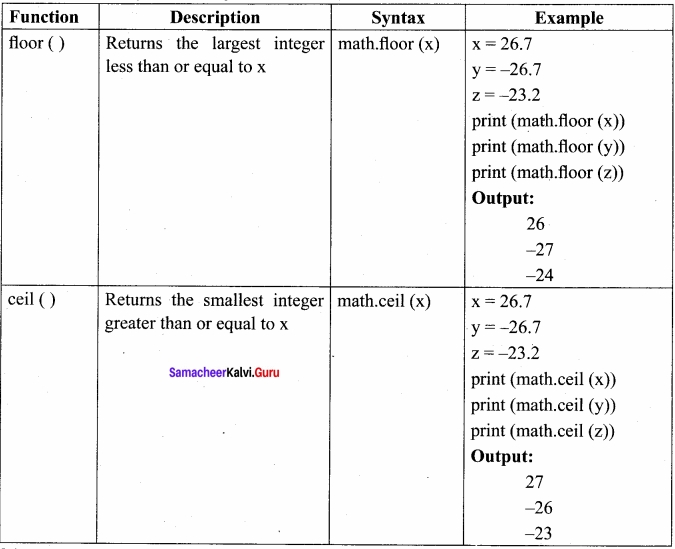
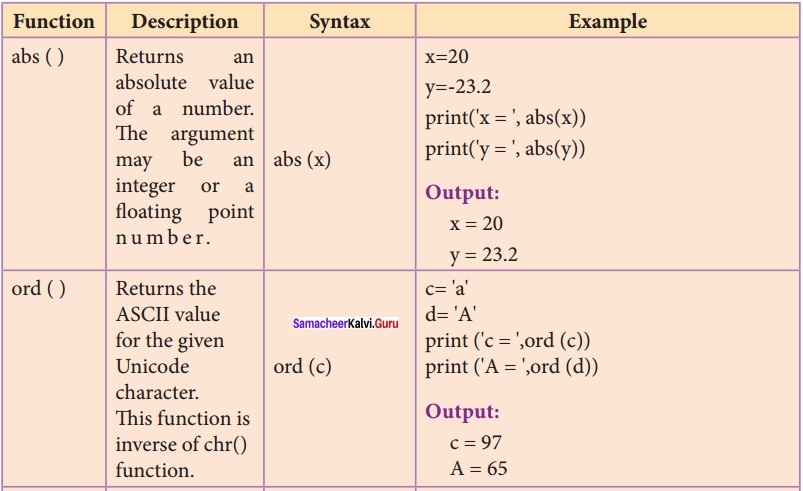
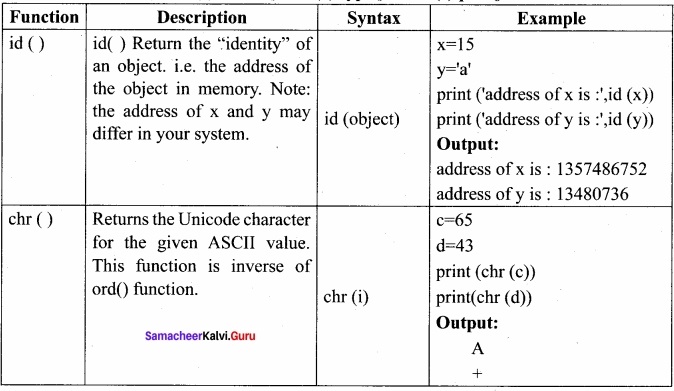
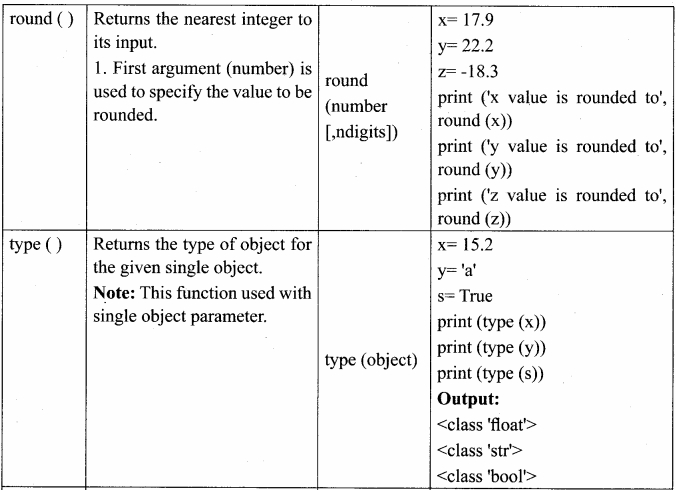
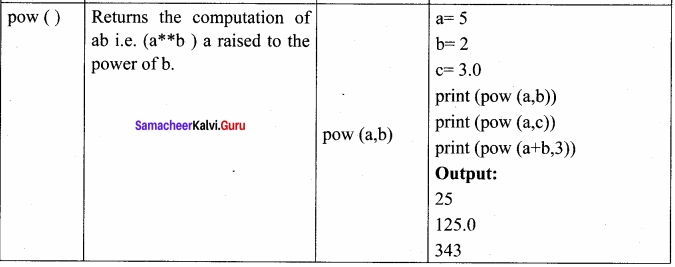
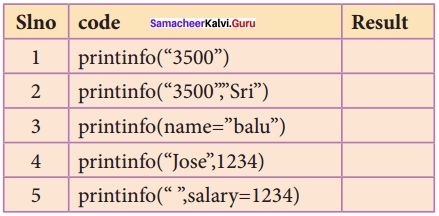
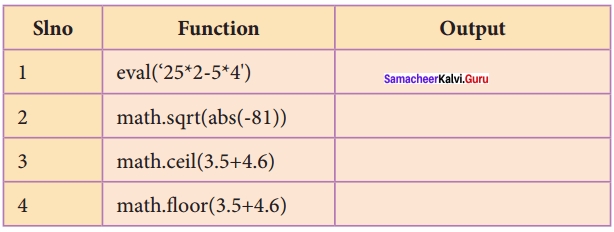
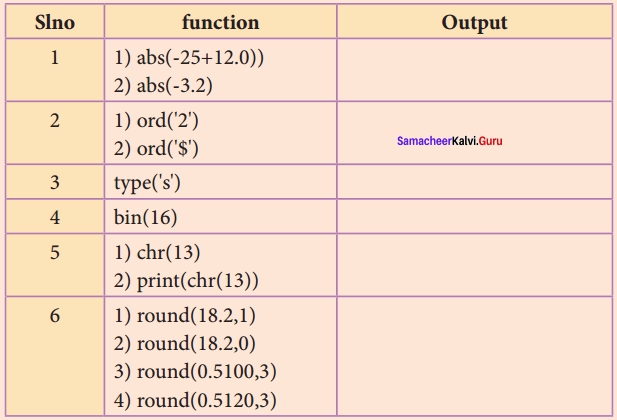
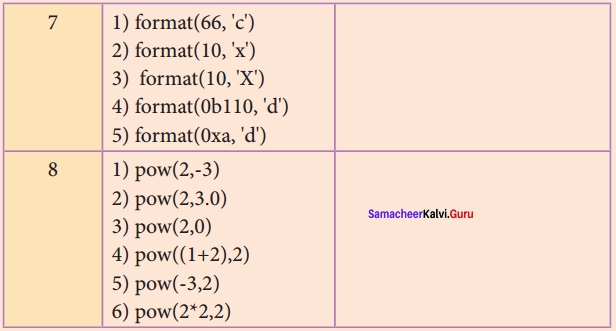
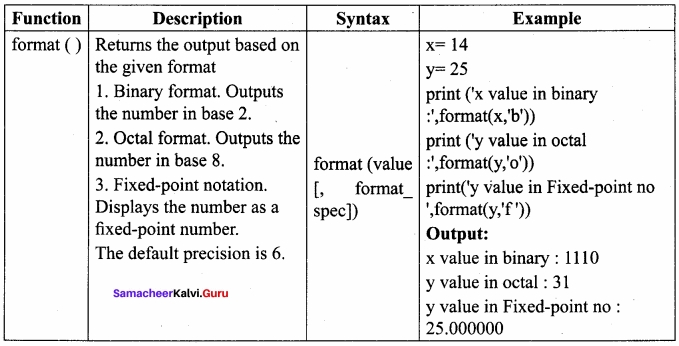
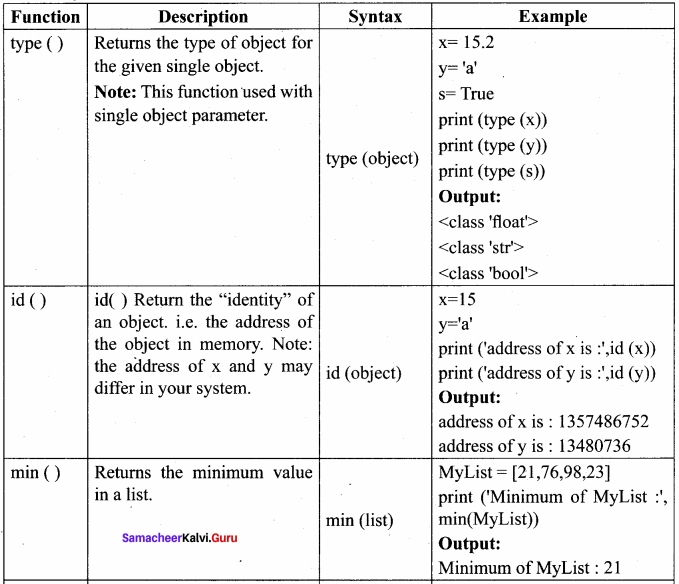
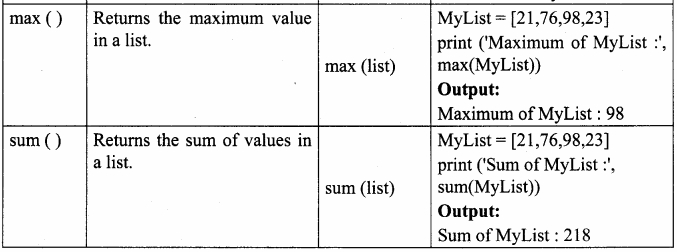


















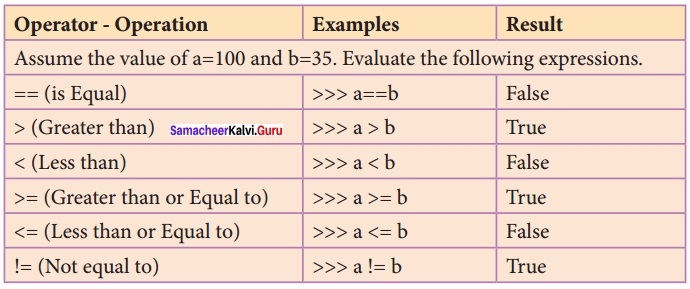






 x 100
x 100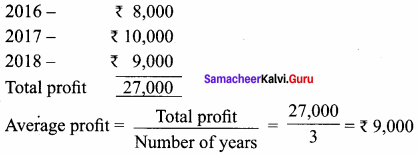
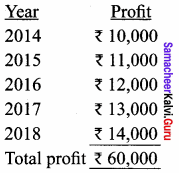

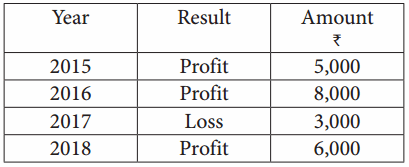
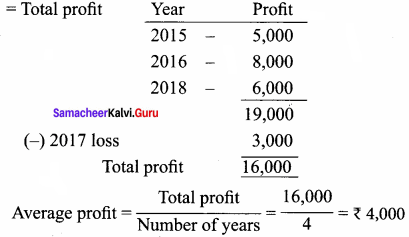
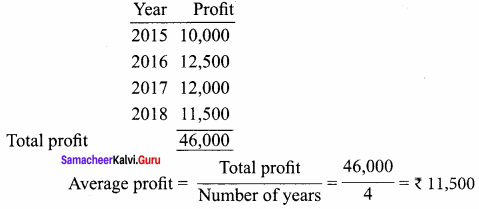



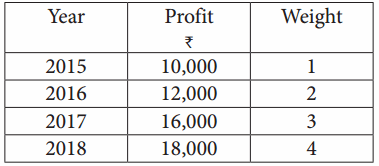

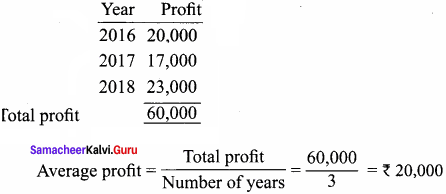

 = \(\frac { 1, 62, 000 }{ 4 }\)
= \(\frac { 1, 62, 000 }{ 4 }\) x 100
x 100 x 100
x 100
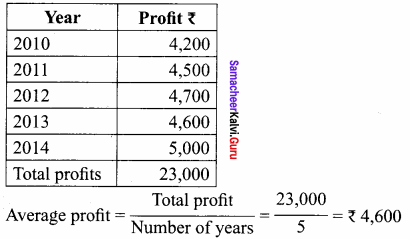
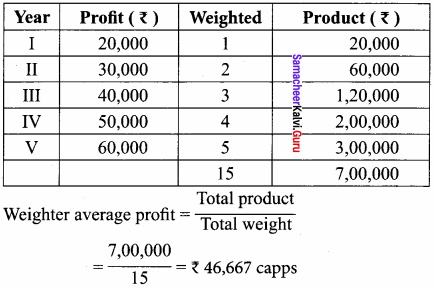

 x 100
x 100